7 of the Best Road Trip Destinations for Gem Hunting
Who doesn’t love a good old-fashioned treasure hunt? Road tripping by car or RV to some of the best gem hunting destinations in the United States is a travel bucket list item. The beauty and majesty of gemstones in person is something to marvel at even if you're not interested in actually searching for them. Plus, having treasure to take home with you is exciting.
One of the things to keep in mind about gem hunting at some of these locations and others is that many are in the middle of nowhere. You may need to bunker in an RV, stay at lodgings provided by the mine, or consider traveling a long distance for a day trip. Make sure to take the time to plan out what your gem-hunting road trip looks like, so you’re not surprised by where it takes you.
Gem hunting may not spark your fancy, but road tripping or RVing to one of these destinations is an adventure in-of-itself. Many of these locations have so much to do in, and around the mine, you may not strike gold, but you may learn a thing or two and see some beautiful scenery along the way.
Here are seven of the best destinations in the United States for gem hunting, rock hounding, and adventure.

Emerald Hollow Mine, North Carolina
Located in Hiddenite, North Carolina, Emerald Hollow Mine couldn’t be situated in a more appropriately named place. Discover emeralds at the only public prospecting destination for emeralds in the United States. Using one of three sluiceways, you’ll pick your bucket that comes down the line directly from Hiddenite’s emerald mine. If you’re lucky, green gemstones aren’t the only treasure you’ll find. You might get your hands on amethysts, topaz gems, or even aquamarines.
Hiddenite Family Campground has partnered with Emerald Hollow Mine to encourage visitors to stay nearby. Surrounded by the Brushy Mountains, this emerald mine is often touted as one of the most unique geological locations in North America. Visitors will be able to hike and explore the surrounding areas between emerald hunting. Consider getting there later in the day as this is a prime spot for local school field trips.
Crater of Diamonds State Park, Arkansas
Located in Murfreesboro, Arkansas, Crater of Diamonds State Park is one of the only public spaces in the world that allows you to dig for diamonds. Rent tools for your search, or bring your own. With more than 40 rocks, minerals, and other interesting finds in this field of volcanic ground, you’re sure to find something or have fun doing it at Crater of the Diamonds State Park.
Crater of Diamonds State Park offers more than gem hunting for travelers. Consider camping there, taking part in a nature hike or a fishing trip, or learning more about the wildlife and birds in the park. If camping or RVing isn’t your type of trip, consider one of the local motels or riverside resorts. Murfreesboro is also full of history, including the Ka-Do-Ha Indian Village Museum.
Gem Mountain, Montana
Gem Mountain is located in Philipsburg, Montana, a remote area in western Montana. The time it takes to get there is worth the fun you'll have digging for sapphires. Everything you need to get started will be provided with admission. Gravel is typically priced by the bucket, and the staff at Gem Mountain will help you screen out what’s worth keeping and what’s worth throwing back into the dirt.
One of the biggest perks of traveling to Gem Mountain is its proximity to Glacier National Park and Yellowstone National Park. so consider visiting one of them while you're in the area. In "Gold West Country," Gem Mountain isn't the only attraction—consider visiting the Philipsburg Chamber of Commerce while you're there to learn about local events, where to stay, and what to do in and around the town.
Herkimer Diamond Mines, New York
Located in Herkimer, New York, Herkimer Diamond Mines doesn’t have actual “diamonds,” but rather quartz crystals that resemble diamonds and are hidden within its caves and the ground below. These 500 million-year-old crystals can be found as easily as brushing against a wall or by getting dirty with a hammer and chisel.
Herkimer Diamond Mines is just 30 minutes away from a Kampgrounds of America (KOA) campground for you to stay at during your journey. The KOA features three dining areas, unique lodging options, and events hosted throughout the season. You're close enough for a day trip to the Utica Zoo, the Adirondack Scenic Railroad, and cider mills galore.
Royal Peacock Opal Mine, Nevada
Located in Virgin Valley, Nevada, Royal Peacock Mine features some of the most gorgeous black fire opals you’ll find in North America. This is one of the more expensive gem hunting expeditions you’ll go on but it's well worth it, especially if you dig within the bank area. The bank area is where the highest concentration of fire opals hide and costs $190 per day per person to dig there, but if you want a bit cheaper experience without as much of a payoff, consider the dumps and tailings of the mine for $75.
Royal Peacock Mine offers lodging, history, and more in the Virgin Valley. With a fully-loaded RV park and additional lodging available, you can spend your time exploring the area. Come prepared because you are 100 miles from the closest full grocery store when visiting this Nevada institution. Make sure to book early because Royal Peacock Mine is only open from May 15 to October 15 every year.
Cherokee Ruby and Sapphire Mine, North Carolina
Located in Franklin, North Carolina, the Cherokee Ruby and Sapphire Mine walks you through the process of finding rough gemstones before screening them yourself. You get to participate in every step along the way to finding rubies, moonstones, garnets, sapphires, and more. If you truly want a hands-on gem hunting experiencing, this is it.
Cherokee Ruby and Sapphire Mine is only open from May through October each year, weather permitting. This Cowee Valley staple is a must visit for gem hunters and enthusiasts. The rubies and sapphires at this mine are some of the most previous in North America and the world. Nestled within the Nantahala National Forest, you're surrounded by fishing, hiking, and bird watching all year.
Gold Prospecting Adventures, California
Located in Jamestown, California, Gold Prospecting Adventures lets you relive the California Gold Rush as prospectors did 150 years ago. Using sluice boxes rather than buckets, you can wade through the contents looking for flakes of gold, small nuggets, or perhaps something a bit bigger to take home. Guides help you learn more about gold prospecting, as well as help those getting started rock hunting for the first time with the best techniques for striking gold.
Jamestown and the surrounding area are full of things to do. Whether It's the Railtown 1897 State Historic Park or a day trip to Yosemite National Park, you won’t be bored on this trip, that’s for sure. Consider hiking the mountain trails out of town or learn the history of the California Gold Rush while visiting.
8 Top Things to Do in Philipsburg, Montana
The 9 Best Fake Engagement Rings for Travel of 2024
Science Says This Is the Perfect U.S. Road Trip
The Best Beach in Every State
The Best Road Trips in the US
The Spookiest Road Trips in the United States
The Best Small Town in Every State
North Carolina Theme Parks and Amusement Parks
The Best Places for a Camping Getaway
Great Summer Family Trips in the USA
U.S. National Parks by State
Red Rock Canyon State Park: The Complete Guide
The Best Camping Spots at Lake Tahoe
13 Top Things to Do at Lake Tahoe
15 Best Northern California Beaches You Shouldn't Miss
Camping in Whitefish, Montana and Glacier National Park

Some articles on Fair Dinkum traveller may contain compensated links. Please read the disclaimer for more information.
The Best Vacation Destinations For Crystal Hunters In The World
Aug 5, 2023 | Travel | 0 comments
Are you a crystal explorer? Where will you go when exploring the best Destinations In The World For Crystal Hunters?
Crystal hunting is a unique and exciting way for adventurous travellers who want to learn more about nature’s wonders to connect with it. From the beautiful quartz mines in the United States to the ethereal crystal caves in Mexico, the best vacation spots for crystal hunters offer a wonderful mix of geological wonders, cultural experiences, and the thrill of finding beautiful and rare crystals.
More than just a hobby, crystal hunting offers a chance to explore the world’s breathtaking landscapes while embarking on a treasure hunt with precious gems and crystals.
We will delve into the top destinations for crystal hunters across the globe, providing essential information, tips, and insights to make the most of your crystal-hunting vacations.

The Best Vacation Destinations For Crystal Hunters In The World.
Top Destinations In The World For Crystal Hunters To Explore
The destinations in this article were chosen carefully based on their accessibility, safety, and the rarity of crystals found.
As we talk about each place, we’ll highlight the best spots for crystal hunting and the importance of ethical collection practices and preserving the natural environment. Responsible crystal-hunting means following the area’s rules, not leaving traces behind, and respecting these regions’ ecosystems and communities.
These destinations promise an unforgettable experience that combines the thrill of exploration with a deep appreciation for the Earth’s geological wonders! You have all the reasons in the world to go crystal hunting while you travel if you haven’t experienced it before.
The Quartz Mines of Arkansas, USA
The Quartz Mines of Arkansas, USA, stands as a shimmering beacon in the world of crystal hunting, attracting enthusiasts from all corners of the globe. Located in the scenic state of Arkansas, this destination has earned a reputation for its abundance of quartz crystals .
Arkansas is called the “Quartz Crystal Capital of the World” because of the state’s many kinds of quartz crystals. It’s a sought-after destination for crystal hunters due to its unique geological formations. While exploring the mines and dig sites, you are transported back to witness the ancient forces that shaped these remarkable geological formations.
Once you’ve filled up your pockets with gems, you can always check out the gem and crystal pricing guide from Rock Chasing to find out how much they are worth. It’s pretty surprising how valuable some of these can be.
Places you can also visit
Beyond the Quartz Mines of Arkansas, you can also head to the nearby Hot Springs National Park. This geothermal gem is close to Hot Springs, Arkansas, and a must-see for crystal hunters who want to relax and refresh after a day in the mines.
Another area you can visit is Mount Ida. It’s a gateway to a world of sparkling treasures hidden beneath the Earth’s surface. Crystal hunters flock to this charming destination, surrounded by the beauty of the Ouachita Mountains, for an immersive and rewarding crystal-hunting experience.
Diamond Hill Quartz Mine, Ireland
The Diamond Hill Quartz Mine is tucked away in the green countryside of County Waterford, Ireland. It’s a hidden gem for crystal hunters who want a unique experience. Even though it isn’t massive, this mine is known worldwide for its unique and high-quality quartz crystals.
This is an excellent place for crystal enthusiasts to uncover stunning specimens while enjoying the scenic beauty of the Irish countryside. The crystals, often called “rock crystals” or “clear quartz,” are apparent and can be of different sizes and shapes.
Exploring the Diamond Hill Quartz mine is a fun way for crystal hunters to learn about geology. Local experts and guided tours enhance the experience by providing valuable insights into the geological significance and formation of the crystals found in the mine.
The Comeragh Mountains are one of the places nearby that are worth seeing. These mighty mountains have rough terrain with beautiful views, valleys, and lakes. Crystal hunters can use the mountain’s well-marked hiking trails to explore nature while keeping an eye out for rocks and crystals.
The historic town of Dungarvan is close to the Diamond Hill Quartz Mine for those who want to go on a cultural trip. People know Dungarvan for its long history, beautiful harbour, and traditional Irish charm. Crystal hunters can stroll through the town’s streets, visit historical sites, and go to museums and art galleries to learn more about the history and culture of the area.
The Crystal Mountains of Switzerland
The Swiss Crystal Mountains are a sparkling paradise for people who want to find crystals. They are nestled in the beautiful Swiss Alps. This beautiful place is known for its rich geological formations, which hold a lot of valuable crystals and minerals. Crystal lovers can have an exciting adventure in the Crystal Mountains, which combine the allure of exploration with the beauty of the alpine scenery.
Crystals of all shapes, sizes, and colours can be found in the mountains, from quartz and amethysts to fluorite and beryl. Collectors and hobbyists will be amazed by the crystal-rich deposits that are all over the alpine terrain and offer a lot of chances to make good finds.
As explorers walk the mountains, they will come across the area’s unique geology, a crucial part of how the crystals formed. Whether hiking through beautiful valleys or up rocky peaks , every step lets you see the beauty of the Crystal Mountains.
The Swiss Alps, known for its famous peaks and beautiful landscapes, are an excellent place for crystal hunters to explore. You can do many things that combine the fun of crystal hunting with the excitement of exploring the mountains.
Many hiking trails and mountain paths in the area go through valleys, alpine meadows, and glacial landscapes. This gives you plenty of chances to look for crystals while enjoying the gorgeous views. You can also go crystal hunting at certain places to find many crystals like quartz, fluorite, and calcite in the rocks.
You can access certain places in the Gotthard Massif that are known to have mineral and crystal deposits . Quartz crystals and other minerals can be found in the Gotthard Pass area in the middle of the Gotthard Massif.
In some places, you can go on guided tours and excursions that teach you about the geological processes that formed the crystals in this mountainous area.
Amethyst Mines of Uruguay
Crystal hunters can find a treasure trove of amethyst crystals in Uruguay’s Amethyst Mines. Geological conditions in the area have helped giant amethyst crystals grow, making it an excellent place for both experienced collectors and people who are new to this hobby.
The amethyst mines are the best place to find high-quality crystals, whether looking for small, polished stones or digging for more giant geodes.
Exploring the Uruguayan Amethyst Mines is a fascinating geological experience that shows the wonders of how the Earth was made. Guided tours and trips into the mines can teach you a lot about how the amethyst crystals were formed.
You can learn about how volcanic activity and mineral-rich environments formed these beautiful gems over millions of years by volcanic activity and mineral-rich environment. As you dig through the rich soil, you can be taken back in time and discover the Earth’s geological history.
This is a unique place where you can simultaneously learn about geology and hunt for crystals. Anyone who visits this sparkling wonderland will never forget it!
Artigas is known as the “Amethyst Capital of Uruguay,” it’s a great place to stay if you want to go crystal hunting in the nearby mines. Many shops and markets in the town sell a wide range of amethyst crystals and jewellery made from gems found in the area.
Artigas also has an annual Amethyst Festival, a celebration of the area’s rich mineral resources and where people can enjoy cultural events, art shows, and auctions and trades of crystals.
Another noteworthy destination in Uruguay for crystal hunters is Las Vegas, which is close to the border of Brazil. The town is known for its amethyst shops and crystal-related handicrafts made by locals. You can see how raw amethyst stones are turned into intricate jewellery and other decorative items.
Las Vegas is also surrounded by beautiful scenery, which makes it a great place to go for walks and watch birds in the quiet of nature .
Madagascar’s Gem Mines
On the southeastern coast of Africa, the Gem Mines of Madagascar is a paradise for crystal hunters. This beautiful island contains precious gemstones like sapphires, rubies, emeralds, and other rare minerals.
Madagascar is known for its beautiful sapphires, often with unique colours like blue, yellow, and pink. It’s a top place for gem hunters because there are many valuable stones and minerals. Guided tours and trips are a great way to learn about the local gem trade and the cultural significance of gemstones in Madagascar.
The island’s geological history is fascinating. It was shaped by tectonic movements and volcanic activity that happened long ago. When people go to the mines, they can learn about the geological processes that took place over millions of years to turn these valuable minerals into what they are today.
Ilakaka is a lively town close to some of Madagascar’s most famous sapphire mines. It’s known as the “Sapphire Capital of the World.” Crystal hunters can have fun in the busy gemstone markets, where they can buy various sapphires in different colours and sizes.
Ilakaka also gives you a unique cultural experience with its unique customs, food, and the warm hospitality of its people.
Antsirabe is another well-known town near the Gem Mines of Madagascar. It’s known for having a lot of precious and semi-precious stones. You can visit the town’s gem markets to look at tourmalines, aquamarines, and rose quartz, among other stones.
Antsirabe also has thermal springs, giving you a place to relax after looking for gems. People can enjoy soaking in the mineral-rich waters and the peaceful atmosphere of the landscapes around them.
A Recap of The Best Vacation Destinations For Crystal Hunters In The World
All in all, if you want to experience the beauty and mystery of crystal hunting worldwide, these locations offer a varied selection of destinations.
From breathtaking mountain views to cozy countryside cottages, all offering a liberating navigation to some of the best crystal deposits – rest assured the perfect getaway is within reach. Allow yourself to be absorbed by an incredible journey – through nature and history as your guide!
Whether you seek tranquil serenity or energizing exploration, it’s time to embark on your next crystal adventure! Packed with expansive sights and soulful ambience, each vacation destination provides its unique charm that will stay long after your trip concludes.

Where will you go when exploring the best Destinations In The World For Crystal Hunters?
fairdinkumtraveller
Traveller | Australia | Asia A Fair Dinkum Aussie travels Australia and into Asia. #travel

Submit a Comment Cancel reply
Your email address will not be published. Required fields are marked *
This site uses Akismet to reduce spam. Learn how your comment data is processed .
We noticed you're visiting from United States (US). We've updated our prices to United States (US) dollar for your shopping convenience. Use Australian dollar instead. Dismiss
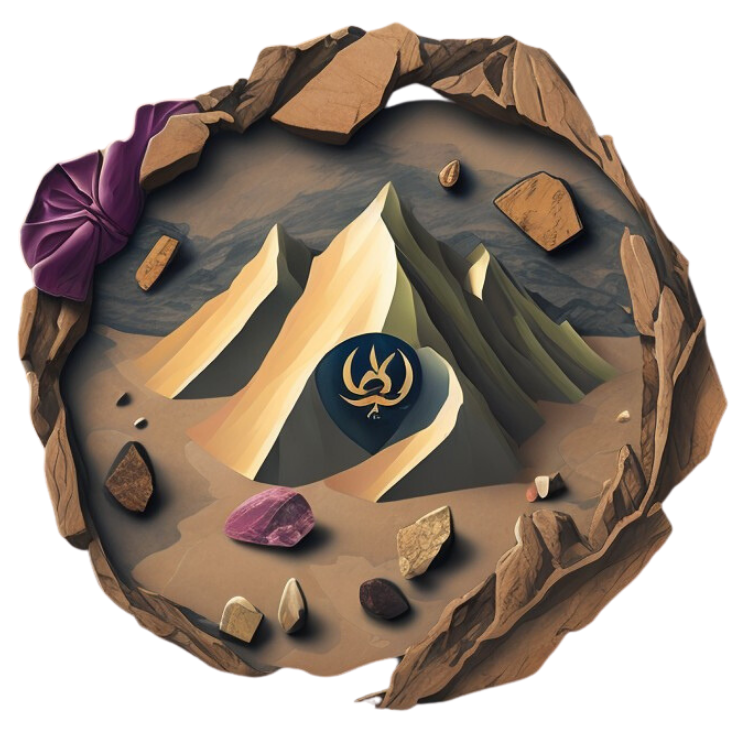
Crystal Hunting Near You: Top Spots for Unearthing Gems in the US
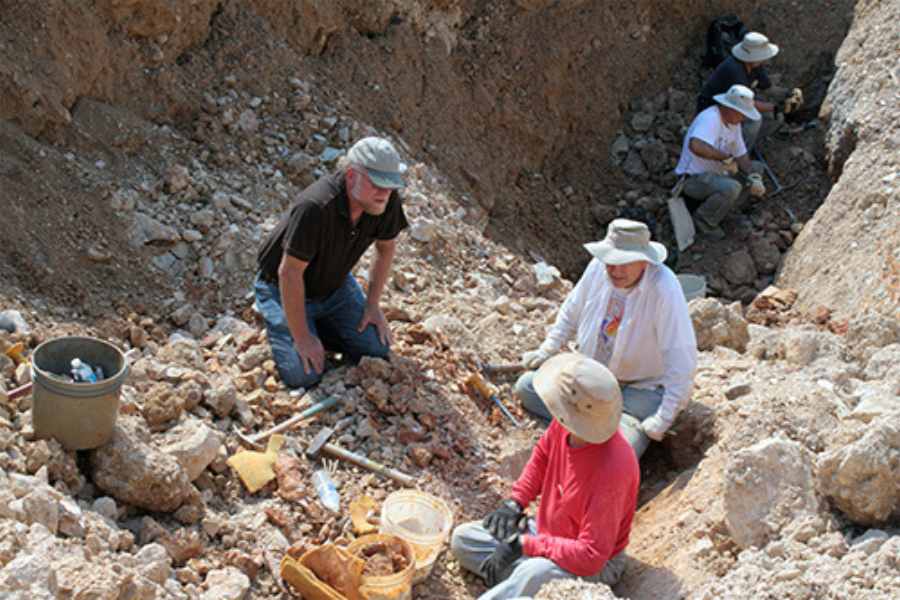
The allure of sparkling crystals, each with its unique properties and beauty, draws adventurers and collectors alike. And why not? Unearthing these precious stones from the earth is an adventure that sparks joy, connects us to nature, and adds a touch of magic to our lives. But where do you begin your crystal-hunting journey?
The United States is home to many crystal hunting spots, where you can dig, pan, or sluice for your own gems. Some of these sites are open to the public for a small fee, while others are free or require a permit. You can keep whatever you find, as long as you follow the rules and regulations of each site.
In this article, we will show you some of the best places to go crystal hunting in the US, and what kind of crystals you can expect to find there. From glistening geodes in the Midwest to sparkling amethysts in the mountains, we will also give you some tips and tricks on how to prepare for your crystal hunting adventure, and how to identify and care for your crystals. Whether you are a beginner or an expert, you will surely enjoy this guide to unearthing gems in the US.
But before we delve into the crystal hunting spots and all of the other exciting information we have for you, we would like to begin from the very basics. If you are familiar with our articles you will know that we love to lay a good foundation for our readers.
What are crystals and how are they formed?
Crystals are solid materials that have a regular and repeating pattern of atoms, molecules, or ions. They can form in different ways, such as:
- Cooling and solidification of molten rock (magma) or lava
- Evaporation or precipitation of water that contains dissolved minerals
- Changes in temperature, pressure, or chemical composition of existing rocks
- Biological processes, such as the formation of shells, bones, or teeth
Crystals can have different physical properties, such as hardness, color, luster, transparency, cleavage, fracture, and crystal system. These properties can help you identify and classify the crystals you find.
What are the benefits of crystal hunting?
Crystal hunting is more than just a hobby. It can also bring you many benefits, such as:
- Learning about geology, mineralogy, and history
- Exploring nature and discovering new places
- Exercising your body and mind
- Developing patience, perseverance, and problem-solving skills
- Enhancing your creativity and imagination
- Finding rare and valuable crystals that can be used for jewelry, decoration, or collection
- Connecting with other crystal hunters and sharing your passion
How to prepare for crystal hunting?
Before you head out to your crystal hunting destination, you need to do some preparation to make sure you have a safe and enjoyable experience. Here are some things you need to do:
- Research the site you want to visit and find out the rules, fees, hours, and availability. Some sites may require reservations, permits, or memberships. Some sites may also have seasonal or weather-related closures.
- Check the weather forecast and dress accordingly. Wear comfortable and protective clothing, shoes, gloves, and a hat. Bring sunscreen, sunglasses, insect repellent, and water. Avoid going out in extreme heat, cold, rain, or storm.
- Pack the necessary tools and equipment, such as a shovel, pick, hammer, chisel, bucket, sieve, magnifying glass, and tweezers. You may also need a map, compass, GPS, or phone for navigation. Some sites may provide or rent some of the tools, but it is better to bring your own if possible.
- Bring some snacks and drinks to keep your energy and hydration levels up. You may also want to bring a first aid kit, a whistle, a flashlight, and a fire extinguisher for emergencies.
- Respect the site and the environment. Follow the instructions and signs, and do not trespass or damage any property. Do not litter or leave any trace. Do not disturb or harm any plants or animals. Do not collect more than you need, and leave some crystals for others to enjoy.
Where to go crystal hunting in the US
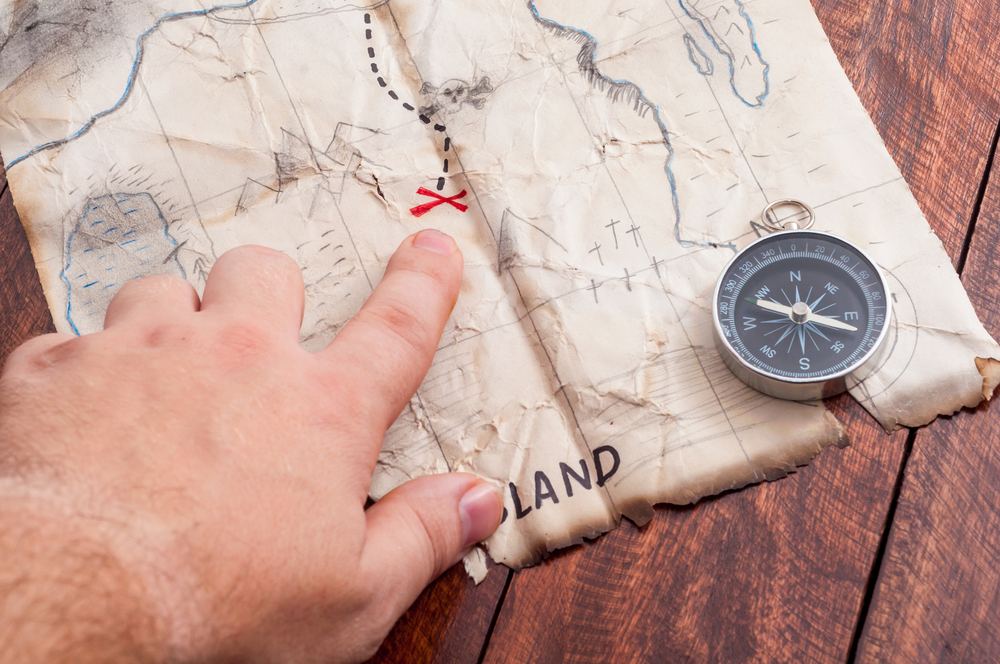
Now that you are ready to go crystal hunting, let's take a look at some of the best places to find crystals in the US. We have selected nine sites that are popular among crystal hunters, and that offer a variety of crystals to suit your preferences. Here they are:
Crater of Diamonds State Park, Arkansas
Emerald hollow mine, north carolina, herkimer diamond mines, new york, crystal grove diamond mine, new york, cherokee ruby and sapphire mine, north carolina.
- Gem Mountain, Montana
Royal Peacock Opal Mine, Nevada
Topaz mountain, utah, quartzsite, arizona.
Let's explore each site in more detail, and see what kind of crystals you can find there.
If you are looking for diamonds, this is the place to go. Crater of Diamonds State Park is the only place in the world where you can dig for diamonds and keep what you find. The park covers a 37.5-acre volcanic crater that was formed millions of years ago, and that contains a rich deposit of diamonds and other minerals.
You can search for diamonds in the plowed fields, or the streams and ponds. You can use your tools, or rent them from the park. You can also take advantage of the Diamond Discovery Center, where you can learn how to identify and evaluate your diamonds. You can also have your diamonds certified by the park staff.
Operating Hours: The park is open year-round, except for Thanksgiving Day, Christmas Day, and New Year’s Day.
Cost: The admission fee is $10 for adults, $6 for children, and free for children under 6. The park also offers camping, hiking, fishing, and other activities.
The park has produced over 75,000 diamonds since 1906, including some famous ones, such as the 40.23-carat Uncle Sam, the largest diamond ever found in the US, and the 8.52-carat Esperanza, the most valuable diamond ever found in the US. The most common color of diamonds found in the park is white, followed by brown and yellow. The average size of diamonds found in the park is about 0.25 carats, but larger ones are also possible.
If you are looking for emeralds, this is the place to go. Emerald Hollow Mine is the only emerald mine in the US that is open to the public. The mine is located in the town of Hiddenite, which is named after a rare green gemstone that is also found in the mine.
You can search for emeralds and other gemstones in three ways: digging, sluicing, or creeking. Digging involves using a shovel and a bucket to dig in designated areas. Sluicing involves using a screen box and running water to wash and sift the dirt. Creeking involves searching in the creek beds and banks. You can use your tools, or rent or buy them from the mine.
Operating Hours: The mine is open year-round, except for Thanksgiving Day, Christmas Eve, Christmas Day, and New Year’s Day.
Cost: The admission fee varies depending on the method of searching, and ranges from $5 to $20 per person. The mine also offers guided tours, educational programs, and a gift shop.
The mine is famous for its emeralds, which are among the finest in the world. The most notable emerald found in the mine is the 1,686.3-carat Carolina Emperor, the largest emerald ever found in North America. The mine also produces other gemstones, such as sapphire, garnet, topaz, aquamarine, amethyst, citrine, and quartz.
If you are looking for quartz crystals, this is the place to go. Herkimer Diamond Mines is a group of three mines that produce quartz crystals that resemble diamonds in shape, clarity, and hardness. These crystals are also known as Herkimer diamonds and are unique to the region.
You can search for Herkimer diamonds in the open-pit mines, where you can break open the rocks with a hammer and a chisel. You can use your tools, or rent or buy them from the mines. You can also visit the museum, where you can learn about the history and geology of the mines, and see some of the best specimens.
Operating Hours: The mines are open from April to October, weather permitting.
Cost: The admission fee is $14 for adults, $12 for seniors, $11 for children, and free for children under 5. The mines also offer camping, lodging, dining, and shopping.
The mines have produced millions of Herkimer diamonds since the 18th century, and are still producing new ones every day. The average size of Herkimer diamonds is about 0.5 inches, but larger ones are also possible. The most common color of Herkimer diamonds is clear, but some may have inclusions of black carbon, water, or other minerals.
If you are looking for more quartz crystals, this is another place to go. Crystal Grove Diamond Mine is another source of Herkimer diamonds and is located near the Herkimer Diamond Mines. The mine is known for its large and high-quality crystals, and for its fluorescent minerals that glow under ultraviolet light.
You can search for Herkimer diamonds and other minerals in the mine, where you can dig, hammer, and chisel the rocks. You can use your tools, or rent or buy them from the mine. You can also use the sluice, where you can wash and sift the dirt.
Operating Hours: The opening hours are from 9:00 am to 5:00 pm, seven days a week, from April 15 to October 15, weather permitting.
Cost: The cost of entry varies depending on the type of digging, and ranges from $10.50 to $25 per person. You can also rent or buy tools from the mine.
The crystals that you will find here are Herkimer diamonds, which are quartz crystals that resemble diamonds in shape, clarity, and hardness. These crystals are unique to the region and are known for their world-class specimens of crystals on matrix and druzy. You may also find some fluorescent minerals that glow under ultraviolet light.
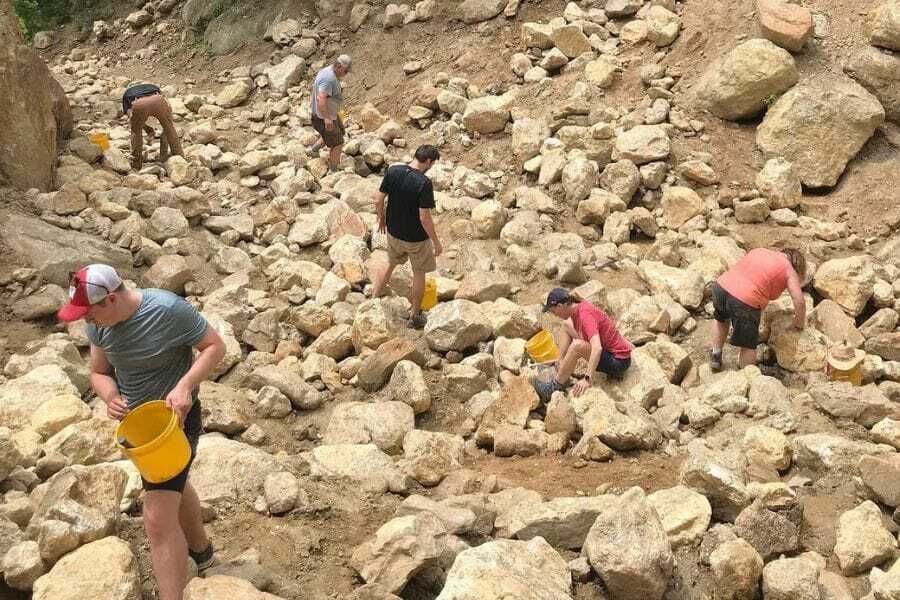
If you are looking for rubies and sapphires, this is the place to go. Cherokee Ruby and Sapphire Mine is one of the oldest and most productive gem mines in the US. The mine is located in the Cowee Valley, which is famous for its rich deposits of corundum, the mineral that forms rubies and sapphires.
You can search for rubies and sapphires by sluicing, which involves using a screen box and running water to wash and sift the dirt. You can use your tools, or rent or buy them from the mine. You can also have your gems identified and appraised by the mine staff.
Operating Hours: The mine is open from May to October, weather permitting.
Cost: The admission fee is $20 for adults, $10 for children, and free for children under 4. The mine also offers camping, fishing, and hiking.
The mine is known for its high-quality rubies and sapphires, which come in various colors, such as red, pink, blue, purple, green, and yellow. The most notable ruby found in the mine is the 2.75-carat Cherokee Star, which was sold for $15,000. The mine also produces other gemstones, such as garnet, moonstone, quartz, and spinel.
If you are looking for topaz, this is the place to go. Topaz Mountain is part of the Thomas Range, a mineral-rich area in western Utah. The mountain is famous for its sherry-colored topaz crystals, which are the state gem of Utah.
You can search for topaz by breaking open the rhyolite rocks, where the crystals are embedded. You can use your own tools, or rent or buy them from nearby vendors. You can also visit the Topaz Mountain Adventures, where you can blast the rocks with high-pressure water and collect the crystals.
Operating Hours: The mountain is open year-round, but the best time to go is in spring or fall when the weather is mild and the rocks are dry.
Cost: The admission is free, as the mountain is located on public land. The mountain also offers camping, hiking, and wildlife viewing.
The mountain is known for its high-quality topaz, which can range from clear to amber to pink. The most notable topaz found in the mountain is the 31-pound King Topaz, which was discovered in 1969. The mountain also produces other minerals, such as red beryl, garnet, amethyst, and quartz.
If you are looking for opals, this is the place to go. Royal Peacock Opal Mine is one of the most productive opal mines in the US. The mine is located in the Virgin Valley, which is part of the Black Rock Desert, a remote and rugged area in northern Nevada.
You can search for opals by digging in the bank, where the opal-bearing clay is exposed. You can use your tools, or rent or buy them from the mine. You can also try your luck in the tailings, where the leftover rocks from previous mining are dumped. You can keep any opals you find, as long as they are not claimed by the mine owners.
Cost: The admission fee varies depending on the type of digging, and ranges from $75 to $190 per person. The mine also offers camping, lodging, and tours.
The mine is famous for its black fire opals, which are the most valuable and rarest type of opals. The opals have a dark background and a vivid play of colors, which can include red, orange, yellow, green, blue, and purple. The most notable opal found in the mine is the 130-pound Royal Peacock, which was discovered in 1992. The mine also produces other types of opals, such as white, crystal, and lemon.
If you are looking for quartz, this is the place to go. Quartzsite is a small town in southwestern Arizona, near the border with California. The town is surrounded by mountains and deserts, where quartz crystals are abundant and diverse.
You can search for quartz by exploring the public lands, where you can collect up to 25 pounds of rocks per day. You can use your tools, or buy them from local shops. You can also visit the Quartzsite Rock and Gem Show, which is held every year in January and February and attracts thousands of vendors and buyers from all over the world.
Operating Hours: The town is open year-round, but the best time to go is in winter when the weather is cool and the rock show is on.
Cost: The admission is free, as the town is located on public land. The town also offers camping, RV parks, museums, and events.
The town is known for its wide variety of quartz, which can include clear, smoky, rose, amethyst, citrine, and agate. The most notable quartz found in the town is the 700-pound Quartzsite Crystal, which was discovered in 1989. The town also produces other rocks and minerals, such as turquoise, jasper, calcite, and gold.
Other Great Crystal Hunting Sites in the US
- Salt Plains National Wildlife Refuge, Oklahoma: A 32,197-acre refuge in north-central Oklahoma, where you can dig for selenite crystals. The crystal digging season is from April 1 to October 15, and admission is free. You can keep up to 10 pounds of crystals per day.
- Rainbow Ridge Opal Mine, Nevada: One of the most productive opal mines in the Virgin Valley, Nevada. Open from Memorial Day to mid-September, and the admission fee is $190 per person for digging in the bank, or $75 per person for digging in the tailings. You can keep all the opals you find.
- Bonanza Opal Mine, Nevada: Another source of black fire opals in the Virgin Valley. Open on weekends from late May to Labor Day. Admission fee is $70 per person for adults, and free for children under 12. You can keep all the opals you find.
- Wegner Quartz Crystal Mine, Arkansas: A popular destination for quartz crystal digging in Arkansas. Open year-round, admission fee varies from $10.50 to $25 per person. You can keep all the crystals you find.
- Himalaya Tourmaline Mine, North Carolina: The only emerald mine in the US open to the public, located in Hiddenite, North Carolina. The mine produces emeralds, sapphires, garnets, topaz, aquamarine, amethyst, citrine, and quartz crystals. Admission fee varies from $5 to $20 per person. You can keep all the gemstones you find.
Read this article " Finding Rockhounding Locations in the United States ." For more details on locations near you where you can rockhound and find other exciting rocks, minerals, and fossils.
How to care for your crystals
After you have found your crystals, you need to take good care of them to preserve their beauty and energy. Here are some tips on how to care for your crystals:
- Clean your crystals regularly, especially after digging or handling them. You can use water, soap, vinegar, or salt to remove any dirt or dust. You can also use a soft brush or cloth to gently wipe them.
- Charge your crystals periodically, especially if you use them for healing or meditation. You can use sunlight, moonlight, fire, earth, or other crystals to recharge your crystals. You can also use sound, intention, or prayer to activate them.
- Store your crystals properly, especially if you have a large collection of delicate specimens. You can use boxes, bags, cases, or displays to protect your crystals from damage or loss. You can also use labels, cards, or catalogs to identify and organize your crystals.
Embarking on a crystal-hunting adventure can be an enriching experience, allowing you to connect with nature and uncover the beauty hidden beneath the earth's surface. As you plan your next crystal-hunting excursion, consider these top spots in the United States, each offering a unique and rewarding opportunity to find these captivating gems.
Remember the Ethics: Always follow responsible collecting practices. Obtain proper permits when required, respect private property, and leave no trace behind. By being mindful of our impact, we can ensure these crystal treasures remain available for future generations to enjoy.
American South
A Smithsonian magazine special report
Finders, Keepers: Five of the Best Places to Go Gem Hunting in the U.S.
From diamonds to emeralds, the United States is full of buried bling
Jennifer Nalewicki
Travel Correspondent
:focal(1380x238:1381x239)/https://tf-cmsv2-smithsonianmag-media.s3.amazonaws.com/filer/d0/ea/d0ea1dd7-4a0c-449d-905b-b563fb3b5c26/42-17493873.jpg)
Do you dream of the good life? For a lucky few, treasure may lie hidden beneath your feet. Across the United States there are dozens of public mining and digging sites packed with everything from diamonds and emeralds to jade and sunstone. The secret is knowing where to sink your shovel.
Often called “rockhounding,” the search for gems and minerals has been popular for decades. One of the earliest accounts of mining in what is now the United States comes from the Pueblo , a Southwestern tribe that began mining for turquoise some 2,600 years ago. As early Anglo settlers spread the word about the wealth of buried treasures beneath the land, immigrants flocked to the colonies to stake their claim.
The hunt for buried treasure is so interwoven into U.S. history that even today every state in the union has either a state gem or mineral —or both. ( Generally speaking , minerals are inorganic objects containing a specific chemical makeup and molecular structure. Gems are precious or semiprecious minerals that can be cut and polished into colorful stones. Gold is neither a gem nor a mineral—it’s a chemical element.)
Today nearly every state has at least one fee-based mine or dig site that’s open to the public with a "finders, keepers" policy that allows visitors to pocket their finds. (Some places will even cut, polish and set found minerals into jewelry for a fee.) In North Carolina, for example, 50,000 treasure hunters try their luck at Emerald Hollow Mine each year. It’s the only site in the country where the public can search for emeralds and North Carolina Hiddenite, a lime-green gem (from the mineral spodumene ) discovered in the area in 1879. The rare specimen can prove elusive, but it’s all about the thrill of the hunt.
“Hiddenite is small and can be difficult to find,” Jason Miller, co-owner of Emerald Hollow Mine, tells Smithsonian.com. “Oftentimes people mistake it for green bottle glass, because a shard of glass looks very similar.” North Carolina isn’t the only state that can call dibs on a unique gem or mineral.
Most gem hunters visit sites like Emerald Hollow Mine for the fun of it, but for others, like Karla Proud, it’s a profession. Proud has been hunting gems since her grandfather, a miner during the Great Depression, took her on a digging expedition in the 1950s. She specializes in finding Oregon Sunstone , the state gem (from the mineral labradorite ) characterized by its glittery, orange-red hue and formed as the result of lava flow from volcanic eruptions that occurred millions of years ago.
Proud sells the cut and polished gems as jewelry, but sometimes her work takes her beyond her home state. One of her greatest hauls was in 1972, when she discovered massive quantities of tourmaline in a mine she and her ex-husband leased in Pala, California, 60 miles north of San Diego. One of her finds, called the “Candelabra” tourmaline (from the mineral elbaite ), is now on display at the National Museum of Natural History in Washington, D.C. Another, also a tourmaline, wound up on a ten-cent postage stamp in 1974.
“One of the foremen called me on the phone late at night, and his voice was shaking,” Proud tells Smithsonian.com. “At first I thought someone had been hurt, but he was just so excited. [My ex-husband and I] grabbed a case of beer—you didn’t have plastic water bottles back then—and drove to the cave. It was so dark inside that we were pouring beer on the specimens to see what their colorations were.”
Although Proud hasn’t struck similar paydirt in a while, she’s still an avid collector and is well known within the greater gem and mineral community. She joins pros and amateurs alike most winters at the Tucson Gem & Mineral Show in Arizona. The largest show of its kind in the world, annual event features panel discussions, lectures, booths and gems galore.
Though many attendees go for the jewelry, Gloria Quigg, publicity and show chair for TGMS, tells Smithsonian.com that part of the draw is the chance to mingle with other collectors who see the show as a chance to show off their finds. Not every gem on display looks impressive, but don’t discount seemingly simple rocks and stones. Quigg says that often, rockhunters choose to keep their finds intact rather than cut and polish them. Either way, the show offers plenty of chances to see specimens without getting dirty.
Jeffrey Post, who curates the Smithsonian Institution's National Gem and Mineral Collection , was at the Tucson show last February, where he rubbed shoulders with amateur and pro rockhounds and scored some rare gems. Among his finds was a tourmaline crystal cluster from Brazil called "the cranberry crown": a gem studded with delicate, nine-inch-long crystals that jut away from its base in all directions. He purchased a domestic, gem, too—an emerald from North Carolina that he tells Smithsonian.com "was unlike anything we've ever seen."
Post, who has been collecting and hunting for gems since he was a kid, says that there's a growing trend of treating and presenting gems as fine art. That rising cachet means rising prices, too. But he says that people can enjoy gem hunting no matter what the budget. Last year, he spent time at Rock Creek, Montana at a working sapphire mine that's also open to the public. He brought along a group of donors and friends, all of whom soon became enamored by the simple task of sifting through a pile of rocks for hidden treasure. "There's a legitimate sense of being able to find something that could be valuable," he says. "I couldn't drag them away."
Intrigued by the idea of finding a bit of bling in plain sight? Here are five public dig sites worth rolling up your sleeves for:
Emerald Hollow Mine (Hiddenite, North Carolina)
/https://tf-cmsv2-smithsonianmag-media.s3.amazonaws.com/filer/c6/bf/c6bf2b81-33a8-4b7e-b633-d73bdf60f556/20150922_160121.jpg)
Tucked in the foothills of the Brushy Mountains in western North Carolina, Emerald Hollow Mine is the only emerald mine in the United States that’s open to the public. It’s also the only spot in the country where North Carolina Hiddenite , a rare gemstone discovered by geologist William Earl Hidden in 1879, can be found. The stone is known for its high chromium content, which gives it a lime-green hue, and forms in the hydrothermal veins of rocks. Visitors to the mine are equipped with a shovel, a pickaxe and a bucket and can hunt for emeralds, hiddenite, quartz and 60 other gems and minerals at its seven-acre dig site. There’s also a full-service lapidary on site that can transform rough stones into glittering mementos.
Crater of Diamonds State Park ( Murfreesboro, Arkansas)
/https://tf-cmsv2-smithsonianmag-media.s3.amazonaws.com/filer/d0/ea/d0ea1dd7-4a0c-449d-905b-b563fb3b5c26/42-17493873.jpg)
A visit to most state parks includes a hike or a bit of fly fishing. But Crater of Diamonds State Park brings something different to the table: some serious bling. Located about 115 miles southwest of Little Rock on the site of a volcanic crater, the park is a hotbed of buried diamonds crystallized from carbon, which formed in the earth's mantle billions of years ago and were thrust to the surface by the crater's explosion. In June 2015, one lucky visitor unearthed an 8.52-carat diamond —the fifth largest specimen found at the park since it opened in 1972—and the site regularly updates its list of record finds. Thanks to the mineral’s brilliant luster, a would-be diamond hunter’s best tool is often their own eyes, and it's not uncommon to find diamonds glistening in the soil.
Jade Cove Trail (Big Sur, California)
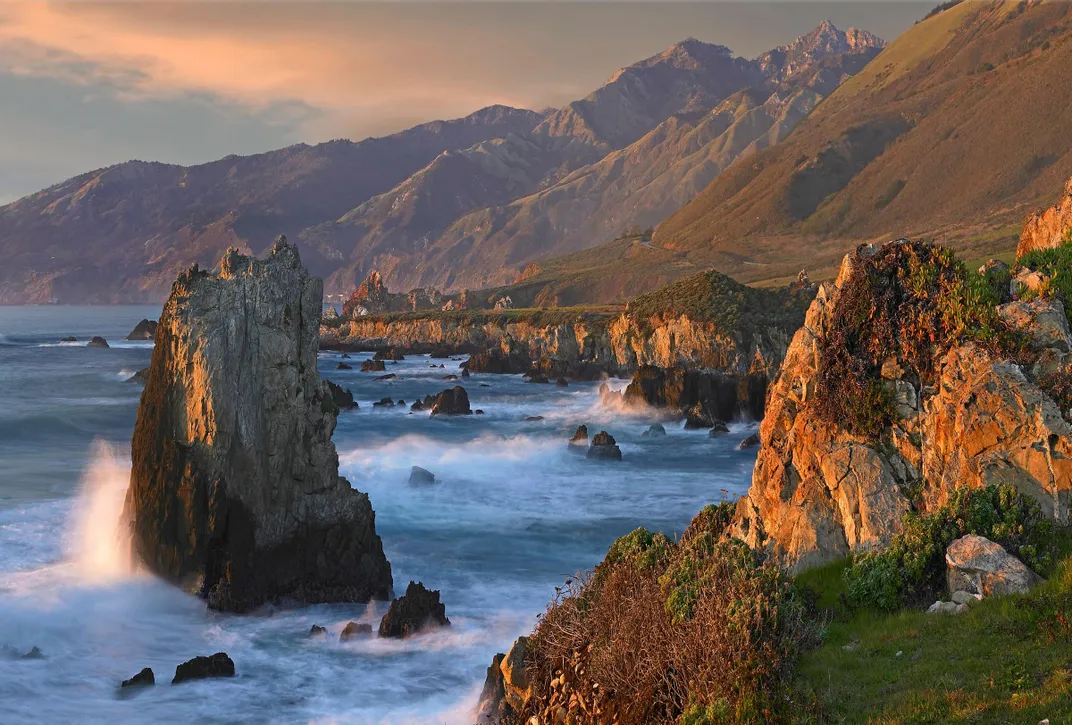
Don’t let the breathtaking ocean views that surround this central California trail distract you from something just as spectacular: the ground. The one-and-a-half mile Jade Cove Trail is a popular spot for jade hunters searching for the greenish-hued gemstone, which forms due to subduction or when oceanic and continental plates collide. Because the trail is part of the Monterey Bay National Marine Sanctuary, the National Oceanic and Atmospheric Administration has released strict guidelines for jade hunting, but as long as specimens are in plain sight, rockhounds are welcome to pocket them. The region is also home to the annual Big Sur Jade Festival . This year, due to the Soberanes forest fire, the event has been rescheduled for the spring.
Morefield Mine (Amelia County, Virginia)
/https://tf-cmsv2-smithsonianmag-media.s3.amazonaws.com/filer/a8/2b/a82b1ea6-7142-49d6-b89d-cae306f7976c/8656953067_8560a827e2_o.jpg)
During World War II, Morefield Mine , located just outside of Richmond, Virginia, was used by military suppliers in search of strategic minerals like mica, beryl and tantalum for use in tanks and artillery. Today, it’s privately owned and is a popular site to hunt for amazonite , a greenish gem named after the Amazon River, and 80 other gems and minerals. Located 300 feet under ground and stretching 2,000 feet in length, the mine is always growing and changing. The area formed more than 250 million years ago when magma pushed from the center of the earth to the surface and cooled, leaving behind massive deposits of minerals. The mine owners periodically use explosives to blast the cave and open up new areas for visitors to explore. Equipped with five-gallon buckets (hammers and pickaxes aren’t allowed), diggers can bring home whatever they can fit into a single bucket.
Graves Mountain (Lincolnton, Georgia)
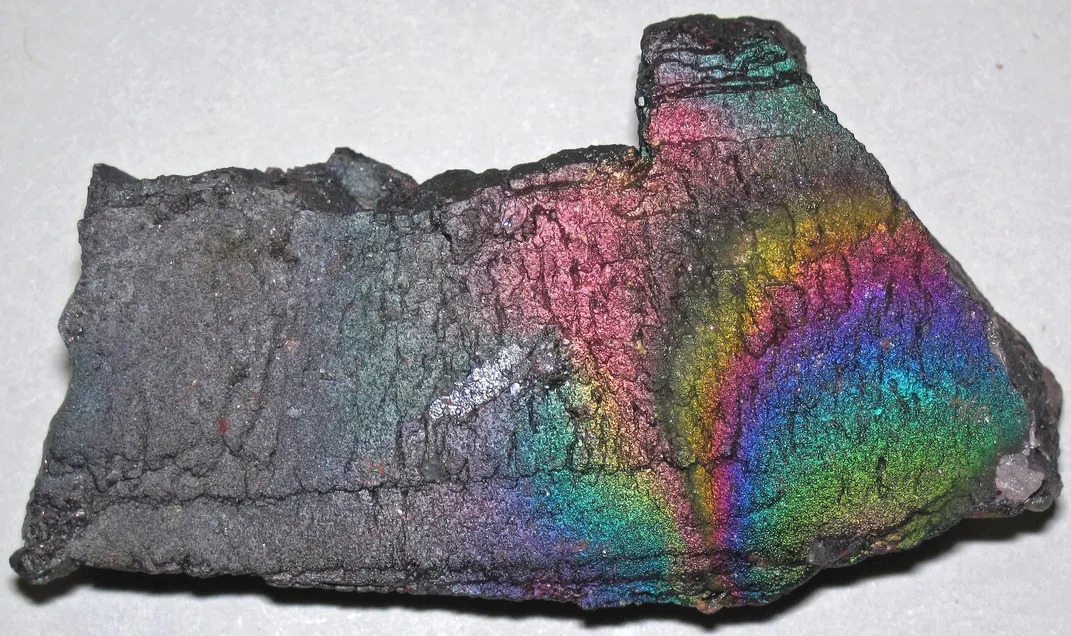
Several times each year, the caretakers of Graves Mountain , located about 130 miles east of Atlanta, invite visitors to dig for buried treasure at this site, which formed millions of years ago when sedimentary rocks metamorphosed . At one time, Tiffany & Co. mined the site for rutile , a crystal-like mineral it used to polish its collection of diamonds. Large traces of the mineral can still be found there today. The mountain’s next dig and rock swap will be held October 7 through October 9—participants can bring their own shovels and hand tools to search for quartz , iridescent hematite , bluish lazulite and other specimens.
Get the latest Travel & Culture stories in your inbox.
Jennifer Nalewicki | | READ MORE
Jennifer Nalewicki is a Brooklyn-based journalist. Her articles have been published in The New York Times , Scientific American , Popular Mechanics , United Hemispheres and more. You can find more of her work at her website .
- Your Cart - $ 0.00
![crystal hunting tour Gem.tours (Treasure Hunting for Rare Gems and Minerals in Utah's West Desert near Delta) [Topaz, Red Beryl, Bixbyite, Quartz & More] (Jeremy Fuller , John Holfert)](https://thegemtours.com/wp-content/uploads/2020/12/logo-thegemtours.com_.png)
Gem tours at famous mines. Collect world-class minerals. Learn from the experts. You can keep what you find. An unforgettable experience!


A Rare Opportunity to Explore Red Beryl in Utah! Open To Public!

$50,000 Crystal Treasure Hunt

AmericanGemTracker - Brian Busse & Jeremy Fuller (Searle Canyon Red Beryl Mine, Topaz & Bixbyite.

Finding Red Beryl, Topaz and Bixbyite at the Searle Canyon Red Beryl Mine at Topaz Mountain

Red beryl.....Utah’s Thomas range

Long Version - Topaz, Pseudobrookite and Bixbyite at the Private Solar Wind Mine near Topaz Mountain

Finding Topaz Crystals and Bixbyite on a Private Mining Claim Near Topaz Mountain, UT

Topaz Mountain

Digging in a Red Beryl Mine in Utah along with a Rock museum and shop -vlog

Solar Wind Mine

SC Red Beryl Mine

This page is having a slideshow that uses Javascript. Your browser either doesn't support Javascript or you have it turned off. To see this page as it is meant to appear please use a Javascript enabled browser.

Continue Reading

- Gem Encyclopedia
- Birthstones
- GIA's Gübelin Gem Project
- Analysis & Grading
- Report Check
- Submit A Gem
- Return Dates
- GIA Facetware ®
- GIA Instruments
- Open Laboratory Account
- Laboratory Service Fees
- Natural Diamonds
- Natural Colored Diamonds
- Laboratory-Grown Diamonds
- Colored Stones
- On Campus Education
- Graduate Gemologist ®
- Graduate Diamonds
- Graduate Colored Stones
- Graduate Jeweler
- Jewelry Design & Technology
- Comprehensive CAD/CAM For Jewelry
- Jewelry Design
- Campus Locations
- Other Locations
- Online Education
- Online Diplomas
- Graduate Gemologist Online Diploma
- Graduate Diamonds Online Diploma
- Graduate Colored Stones Online Diploma
- Graduate Pearls Online Diploma
- Applied Jewelry Professional ™ Online Diploma
- Online Courses
- Jewelry Essentials
- Colored Stone Essentials
- Diamond Essentials
- Diamonds & Diamond Grading
- Gem Identification
- Lab Classes
- Colored Stone Grading Lab
- Diamond Grading Lab
- Gem Identification Lab
- Pearl Grading Lab
- Tuition & Fees
- Financial Assistance & Scholarships
- Career Support
- CAREER PATHS
- Career Fair
- Gem & Jewelry Careers
- Student Consumer Information
- Continuing Education
- Alumni Collective
- Research & News
- GIA Research
- News & Articles
- Gems & Gemology Journal
- Support GIA
- Mission, Governance & ESG
- Careers at GIA
Please choose a language
Arizona road trips: wild west gem and mineral localities.
Sharon Bohannon
November 18, 2019
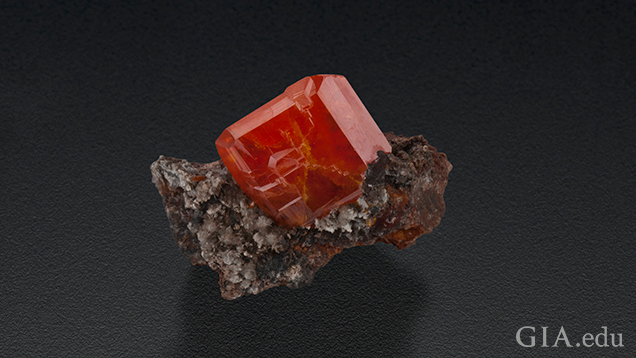
Arizona’s scenic desert and mountain landscape is the perfect backdrop for a modern Wild West road trip ‒ and researching mines for a road trip to gem localities there uncovers stories worthy of a Western movie script.
Red Cloud Mine, La Paz County
Working a desert mine was challenging in the rugged, hot landscape with little access to water, rudimentary shelter and an “every man for himself” attitude that often led to murder in the rowdy mining towns of the West.
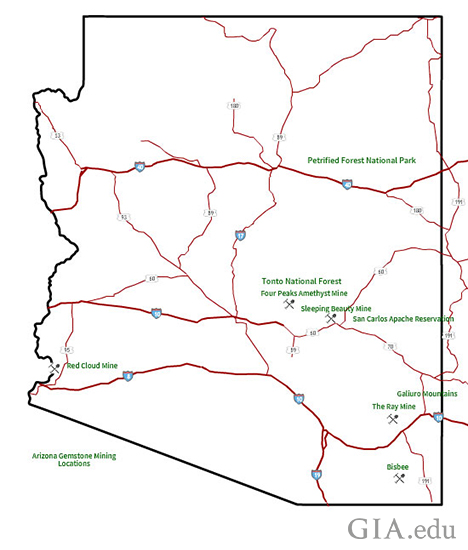
The story of the Red Cloud Mine, located in the southwest corner of Arizona, is set in the gold and silver rush days of the late 1800s and bears just such a story of riches, crime and redemption. Prospector Warren Hammond pawned his shotgun in Yuma, Arizona in 1880 and headed north to stake a claim in an area that would later become the La Paz County Silver District. He struck pay dirt and named the mine Red Cloud after the trail used by early Spanish explorers.
The silver mine flourished and grew to employ 100 miners and the nearby town of Silent expanded to include an assay office, hotel, dance hall and saloons. One saloon owner, according to local history, was shot by a rival who pleaded self-defense, was exonerated and later appointed postmaster.
Silver from the Red Cloud mine has long been dispersed, and the mine is closed, but the mineral wulfenite found there has made its way into collections worldwide. It is known as some of the world’s best for its yellow-orange and red-orange color, as well as its high luster.
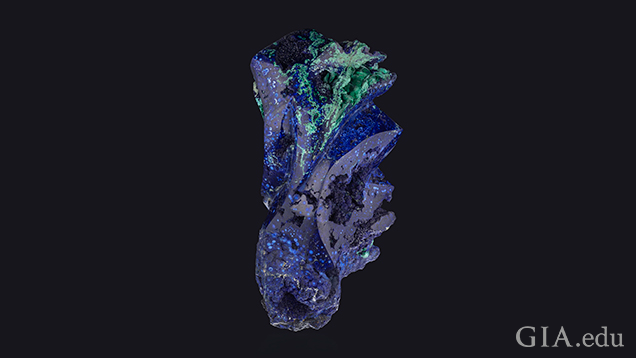
Consider taking a break after the upcoming Tucson Gem & Mineral Show and drive about two hours south on Interstate 10 to Bisbee, an Old West mining town that retains its heritage with historical museums, art galleries and mine tours.
During its heyday, Bisbee was a remote, dangerous, and desolate area where the Apaches roamed the mountains and valleys to protect their land from settlers. Bandits sought refuge in the desolate area or preyed on the vulnerable passing through.
Hundreds of thousands of tons of silver, copper, lead and other ores were produced in the Bisbee area. The area’s legacy, however, lies in the more than 300 mineral species that have been uncovered in the search for silver. Azurite, malachite and turquoise are among the most well-known.

The Ray Mine, Pinal County
The Ray Mine, located 85 miles east of Tucson, is nestled below Teapot Mountain about 12 miles south of Superior on Highway 177. Prior to the late 1870s, local Native Americans worked the copper deposits. By 1880, modern mining operations were set in motion, but it was the railroad line in 1905 that made it possible for the ore to be shipped for processing.
The Ray Mine is famous for its twinned blades of native copper crystals, chrysocolla, malachite, quartz and chalcedony. Owned by ASARCO, the operations and equipment of the Ray mine are available for viewing daily from 7 a.m. to 2 p.m. or until dusk.

Galiuro Mountains
From the Ray Mine head east on Interstate 70 toward the eastern foothills of the Galiuro Mountains southwest of Safford. This region is known for Deer Creek fire agates. There are several mining claims in the area, so be sure to honor private property rights.
In general, it is always prudent to consult with claim holders or owners before venturing out for prospecting on your own.
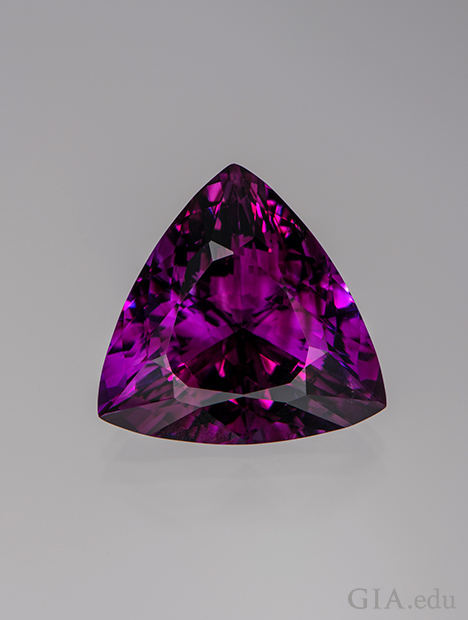
Four Peaks Amethyst Mine, Fountain Hills
The Four Peaks Amethyst Mine is located about two hours east and north of Phoenix in a remote area of the Four Peaks Wilderness area of the Tonto National Forest. Amethyst from this locality exhibits a rich purple hue with flashes of red and blue, and is called Siberian amethyst in the trade. It is rare and collectible both for color and scarcity.
For the adventurer, tours by helicopter or jeep to the Four Peaks mine are availableby appointment from a local business in Fountain Hills, Arizona.

Sleeping Beauty Mine, Globe
On your way to San Carlos Apache Reservation, you will pass through the town of Globe where the Sleeping Beauty Mine is located. The mine, which produced the finest turquoise in the United States, shifted its focus from turquoise to copper in 2012.
San Carlos Apache Reservation, Peridot
The San Carlos Apache Reservation and the Cultural Center are located about 2.5 hours and 135 miles east of Phoenix on U.S. 70 near the town of Peridot, which is named for the world’s largest deposit of the gemstone. Mining of peridot is only granted to residents of the reservation. It is extracted with hand tools and collected in buckets. Garnets are also found on the reservation.
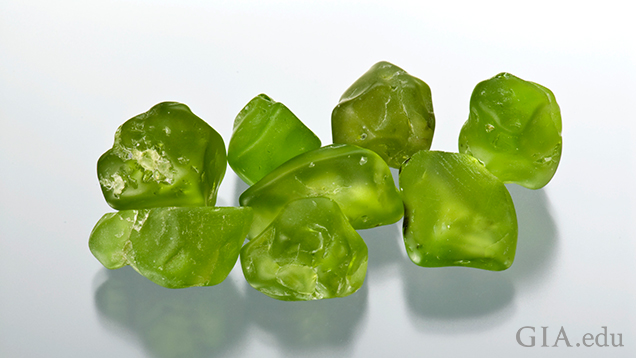
Petrified Forest National Park, Holbrook
An Arizona road trip would not be complete without a drive through the Petrified Forest National Park in northeastern Arizona. Located 110 miles east of Flagstaff along Interstate 40 near Holbrook, the southern portion of the park is full of colorful petrified wood. It is strictly forbidden to remove or collect specimens in National Parks or Monuments. Contact the Bureau of Land Management for areas that allow collection.
The prospect of finding a fortune in gems or minerals on this Arizona road trip is rare, but the memories you collect on your journey will be priceless.
Sharon Bohannon, a media editor who researches, catalogs and documents photos, is a GIA GG and GIA AJP. She works in the Richard T. Liddicoat Gemological Library and Information Center.
You Might Also Like

Find a Retailer

Shop the Campus Store

Subscribe to Knowledge Rocks Emails

Learn About Diamond Origin Reports

Guided Arizona Gem Hunting Tours
Arizona gem hunting tours, what is included.
Transportation to and from the trailhead from your hotel, fresh picnic lunch, trail snacks, day packs, trekking poles, and knowledgeable, licensed, geologist/guides.
What should you bring?
Appropriate clothing for the weather (call for details prior to your hike), water bottles or hydration bladder (3 liters per person), sturdy shoes/boots, waterproof jacket/poncho, hat & sunglasses, camera, sunscreen. During colder weather, warm hats, gloves, and scarves may be great to have. Guide gratuities are customary and greatly appreciated.
Joining a tour
To make a reservation, visit our Reservation Request page. Or call our office at +1(602) 904-2536 , Monday to Sunday, 9am to 5pm AZ time.
Meeting Time & place
Blue Marble can grab you from your hotel in Flagstaff, or you may choose to meet at the designated meeting place, which will be included in your pre-trip information packet. Our meeting time will be arranged upon booking your reservation and is largely dependent on time of year.
Cancellations
To guarantee your reservation we require a 50% deposit. We collect the remaining balance 30 days prior to the hike departing. Any cancellation made more than 15 days prior to departure will receive a full refund less a $30 processing fee. Cancellations made within 15 days will receive a 50% refund and any cancellation made within 72 hours of the hike departing will receive no refunds or credits. There are no refunds for guests who arrive late or depart early from the trip. There are no refunds for late arrivals.
Why Go Guided?
So much of the true wilderness experience comes from being able to understand and interpret what you are seeing. Why are those rocks red? How did this canyon form? What is that tree? What cultural significance are those petroglyphs? Our expert guides will not only keep you safe, relaxed, and intrigued, they will also be able to answer almost any question you have about the landscape you are seeing.
A trained geologist is a person who can interpret millions of years of Earth’s history simply by staring at a rock outcrop for a few minutes. Anyone can read a book about The Grand Canyon, Zion, The Painted Desert, or Death Valley, but seeing it up close and personal is a completely different and extraordinary experience. Our guides will give you knowledge and the intimate experience of truly knowing where you came from.
In addition to our geologic knowledge, our trips also give you the fundamental ability to immerse yourself in the landscape without worrying about food, water, camping arrangements, transportation, driving directions, or any logistical issues that invariably accompany adventure. Let us handle the details, all you need to do is enjoy the ride.
Explore Further, Be Wild, See Through Time.
6 Places You Can Collect Your Own Crystals
Crystals are so ubiquitous here in Los Angeles that I'm beginning to feel like a gem hoarder—everywhere I go, it seems like someone hands me a small rose quartz or a similar stone infused with energy healing properties. When a piece I fancy doesn't find me in this way, I generally seek it out online via one-click ordering.
This doorstep delivery is awesome for busy enthusiasts, but it's definitely not as much fun as the OG method of crystal sourcing, AKA digging for buried treasure. Luckily, recreational gem mining is a thing, and though it's generally more of a diversion than it is a get-rich-quick scheme, a man in North Carolina did discover a 310-carat emerald as recently as 2009, while another lucky human found an 8.52-carat diamond while digging at a tourist-friendly site in Arkansas in 2015.
Chances of striking pay dirt on a dig are about as good as winning the lottery. Buy hey, even if all you manage to unearth are some new, high-vibe specimens for your mantle place, I'd still call that a jackpot.
Below, find 6 places you can indulge your crystal addiction, feel like an old-school explorer, and, maybe, make bank.
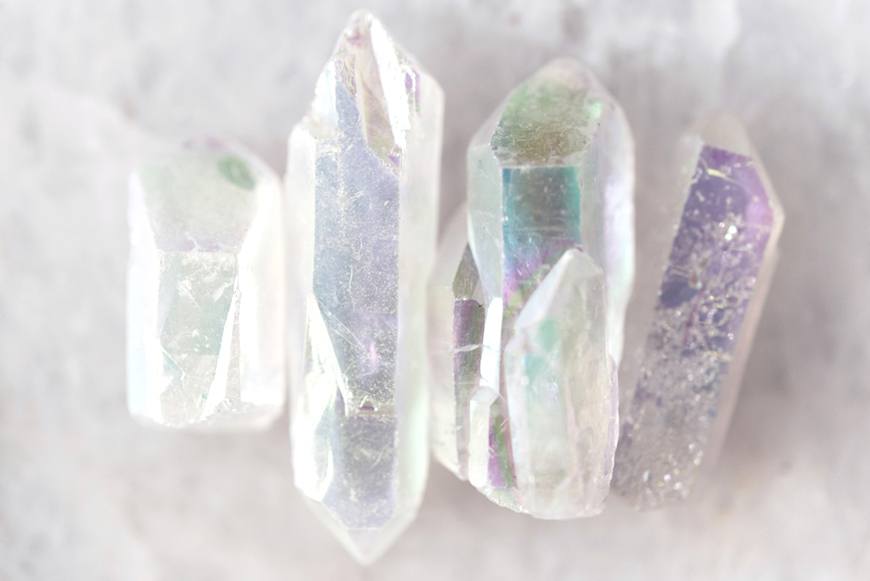
1. Emerald Hollow Mine , North Carolina
Emerald Hollow Mine is located in Hiddenite, North Carolina, which happens to be where the aforementioned lucky explorer found his 310-carat gem. His discovery was made on private property, but Emerald Hollow Mine offers the public a chance at striking similar luck with not only emeralds but also the hiddenite for which the area is known, as well as amethysts, sapphires, topaz, garnet, and more.
{{post.sponsorText}}
Here, you have three options for your search: sluicing, creeking, and digging. In the first scenario, you can sift through what's known as "salted" buckets of dirt, meaning you'll be assured to find crystals within them. Creeking is a slightly more adventurous angle without the guarantee of success—water brings minerals down from the mine and lands them in the shallow creek bed for relatively easy searching. The final option involves a hike to the mine and some real digging. Prices start at $10.
Once you've accumulated your treasure, there is a lapidary on property who can turn your from-the-Earth finds into supercharged jewelry.
2. Craters of Diamonds State Park , Arkansas
This is North America's only public diamond mine, built atop the world's eighth-largest diamond-bearing crater. It was here the 8.5-carat diamond was discovered, but the gem was only one of hundreds of notable jewels—white, brown, and yellow diamonds—found on the property over time. The largest, discovered in 1924, boasted 40-plus carats.
You can seek out your treasure in one of three ways here. The first, surface searching, is exactly what it sounds like—you'll walk up and down the plowed rows of a 37.5-acre field seeking out gems by sight. (This method works best after a rain.) The second involves actual digging, about six inches to a foot down into the soil, and sifting. The third, for experienced miners, involves digging deep holes and strategically sorting through the dirt. Diamond discoveries aren't guaranteed via any of the three methods, though you can see a listing of recent finds here . Entry fee is $10 per person.
3. Jade Cove , California
Unlike the first two locales on this list, Jade Cove—located in the Big Sur area of California—is not commercialized. On the contrary, there are actually a few barriers to entry here: The way down is steep and potentially dangerous; at times the signs pointing the way go missing (locals who want to deter amateur hunters are generally suspected); and there are some regulations which restrict gem recovery . Still, none of the above have stopped local jade purveyors and tourists alike from seeking out this rare gem.
Though some adventurers shore dive here to find jade, it's more commonly searched for by sight in the sand. This is best accomplished at the tideline, though treasure hunters are advised not to turn their back to the ocean as currents are strong. Jade can't always be identified by its color—here, it comes in shades of green, blue, red, black, and brown—but this crystal can be easily verified by its immunity to scratching.
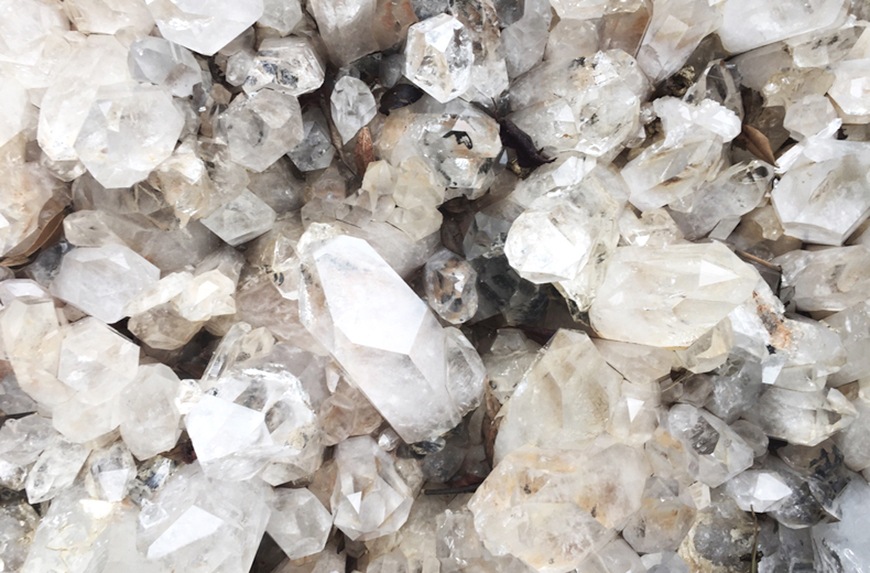
4. Graves Mountain , Georgia
Graves Mountain was first mined in the 1920s by Tiffany & Co, which used the rutile it unearthed to polish diamonds. Now, this mineral-rich mountain is available for digs by appointment only for Georgia Mineral Society members; however, in April and October, Graves' caretaker is opening the grounds to the public for three-day "rock swap & digs." (Could you just die? There will be barbecue, too, and the whole shebang is organized by a man adorably named Junior.) Up-for-grabs gems include iridescent hematite, pyrite, blue quartz, quartz, and other crystals. Entry fee for the public event is by donation.
5. Cherokee Ruby & Sapphire Mine , North Carolina
According to the Cherokee Ruby & Sapphire Mine, a rare type of gem known as the pigeon-blood ruby can be found here. They're more valuable than your average stone— an extraordinarily large one sold at auction in 2015 for $33M —however, some believe this distinction should only belong to certain rubies of Burmese origin.
Regardless, many other crystals—good ol' regular rubies included—can be found here including sapphires, moonstone, quartz, smokey quartz, and more. "Digging" is done through buckets of soil (as opposed to a search into the actual earth). Unlike some crystal mines, however, Cherokee doesn't "salt" these treasure troves, meaning they don't throw in outside gems to sweeten the deal for consumers. The mine is closed from November to May. Fee is $25 per person.
6. Wegner Quartz Crystal Mine , Arkansas
This property is known for—you guessed it—quartz crystals. And while you won't see anything quite this extraordinary in size , clusters are sometimes unearthed here that weigh several tons, and gems are by all account abundant.
There are five options for unearthing stones at Wegner. The first involves searching a 40-acre surface mine by sight and hand tool. The second includes hitting up the sluicing trough, where you can sort through a pail of dirt for crystals including rubies, tourmalines, opals, amethysts, and others. The third option involves searching through a patch of dirt which has been brought down from the mine, and which is salted occasionally to replenish its crystal content. The fourth includes a dig at what's called the Phantom Mine, where you can find rare crystals-trapped-inside-of-another-crystal called Phantoms. Finally, the last option involves diamond hunting through a bag of dirt guaranteed to contain at least 1/2-carat's worth of diamonds. Fees start at $10.50 per person.
Once you've unearthed new treasures, here's how to cleanse them , where to put them in your home , and how (plus, why) to pair them with your plants .
Loading More Posts...
The Beach Is My Happy Place—and Here Are 3 Science-Backed Reasons It Should Be Yours, Too
Your official excuse to add "OOD" (ahem, out of doors) to your cal.
4 Mistakes That Are Causing You to Waste Money on Skin-Care Serums, According to an Esthetician
These Are the Best Anti-Chafing Denim Shorts—According to Some Very Happy Reviewers
{{ successMessage }}
Please wait a moment...
Crystal Hunters’ Paradise in Arkansas: Discover the Best Dig Sites!
by Jeremy Hall April 18, 2022, 11:33 pm updated December 25, 2023, 10:19 pm
Share This Article With a Friend!
Where Are The Best Places To Dig Crystals in Arkansas?
Arkansas can seem lousy with quartz crystals, it’s one of the best places in the world to find them after all! There are innumerable sites spread throughout the state, many of them ready to let you dig and see what you can bring home. It’s just a matter of finding the correct location.
So, want to see where to start looking to find places to dig crystals in Arkansas? Let’s take a look at some of the best!
The following places are all open at the time of this writing, but I encourage you to take a look in the surrounding areas if the spot you’re looking at isn’t open to the public at the moment. Arkansas has an incredible amount of quartz crystals and this is just a small sample of the available sites in the state.
- Quartz: Ultimate Guide To Collecting Quartz
1. Crystal Vista
If you’re a rockhound who lives in or near Arkansas, and you’re always on the lookout for places to go to dig crystals, then chances are you’ve heard of the Crystal Vista crystal dig site.
There’s plenty of quartz crystals to be found here and it’s completely free. You just have to be willing to make the 20 minute uphill trek to the collection area. The good news is, your walk back down to your vehicle will all be downhill!
The Crystal Vista dig site is a 4 acre area that was once a commercial crystal mining operation. After the mine was closed, a local miner and the Forest Service worked together to turn the 4 acre property into a recreational site for rockhounds.
Surface collecting at Crystal Vista can be very productive, especially if your expectations aren’t to find large clusters. What you’re likely to find while surface collecting at this site are smaller sized quartz points, many of which are extremely clear and in great condition.
You can read more about the Crystal Vista dig site in this article: Crystal Vista Arkansas | Dig Your Own Crystals For Free!
2. Wegner Quartz Crystal Mine
The Wegner Quartz Crystal Mine is one of the leading producers in Arkansas, producing an incredible amount of crystals. If you’re the adventurous type, you can check out their paid digs that allow normal rockhounds to get in on the action.
There are two main attractions here: the Crystal Forest Mine and the tailings piles.
The former is an open-pit mine where you can freely dig. You can get your hands dirty or get to some serious work with hard rock mining in the same place. The location currently requires you to bring your own tools or buy them on-site, so make sure you stick your equipment in the car.
It’s one of the most popular paid digs around and the price is great. You’ll only need to spend $18 per 2 hours there, and kids are cheaper. A lot of impressive crystals have come from this area, and it’s not a bad idea to try your hand at it.
The tailings pit is tailings from the commercial operation of the pit. The owners add material to the area on a regular basis and you can get in for a smaller fee than you’d pay to do some actual digging. It’s an easier way to look for crystals, and the pit is handicap accessible.
The Wegner Quartz Crystal mine is located south of Mt. Ida, and you can find more details about their tourism operation on their web page .
3. Coleman’s Rock Shop & Crystal Mines
Another attractive spot to find quartz crystals is Coleman’s Crystal Mines. The location is one of the cheaper paid digs and they offer a money-back guarantee if you don’t find any crystals while you’re searching. Considering the low upfront cost, I’d say it’s well worth a shot.
They’re one of the biggest producers of quartz crystals in the region and they also offer material to be shipped home for you to dig through if you can’t make it to the site.
It’s a tailings dig for the most part. The actual mine is hard rock mining done with heavy equipment, so you’ll be going through things that have already been dug out from the pit proper. There’s a lot of clear crystal in this area and you’re sure to find something.
There’s also a great little rock shop on site. It might not seem like much if you’re coming out of Quartzite but every good rock shop still standing deserves a visit.
Overall, this may not be the most popular dig site for tourists but it can be a great experience. Digging through tailings is normal for a paid dig, and the Rock Shop/Crystal Mine hybrid business model is pretty cool.
Just be aware you’ll want to drag along your own tools. The only thing sold on-site are gardening forks to help rake through the soft material of the tailings. A folding shovel and a screen will make finding great crystals a lot easier.
The mine is a bit north of Hot Springs, Arkansas. You can find more information about the dig on their website .
4. Ron Coleman Mining
In a different location, with a different Coleman heading things, you can find another great quartz mining experience. For $25 an adult can dig all day, starting at 8 in the morning. There’s also a tour of the commercial mine, so you can see how it’s done with heavy equipment and professional diggers.
The site offers a lot of quartz in the tailings and the unlimited dig time is a nice touch. This mine produces primarily clear quartz, there are no significant deposits of amethyst or other varieties to be found. Still, the ability to pull attractive clusters from the ground is a win for everyone!
If you’re local to the area, they even have a calendar where they show how much material has been added to the site. Going in right after a big load of tailings has been added to the tourist area is your best bet for finding exquisite specimens.
They’re even pet-friendly, as long as your dog is leashed and well-mannered. That’s a big bonus for families on an adventure.
Overall, it’s a pretty standard paid dig for Arkansas. On the cheaper side of things too. There are some considerable extras for people who are more tourists than amateur miners. Check out the information on their site to see if it looks good for your trip!
5. Twin Creek Crystal Mine
Located near the Wegner Quart Crystal Mine, south of Mt. Ida, this mine produces some great crystals. It’s a little bit more of a pain to get into since you’ll have to inquire beforehand, but it’s worth a shot if you’re in the area.
The good news? It’s worth it since you’ll be digging in the actual mine rather than going through tailings. Nothing against tailing digs, you can find some great stuff and it helps keep mines open, but actual mining is far more attractive for experienced rockhounds.
They have digging experiences set up for everyone from newbies to seasoned hands, and it appears they do their best to tailor to individuals rather than just being a tourist trap. That alone might make the extra effort you’ll need to put into the inquiry worth it.
If you don’t mind the bit of hassle, check out their site and see if their offerings are what you’re looking for in a crystal dig.
6. Board Camp Crystal Mine
Another of the bigger operations in Arkansas is the Board Camp Crystal Mine. It’s by reservation only, so it’s not good for a “tourist trap” style stop but if you put some forethought in you can get some impressive specimens.
There is also their “UnXplained Tours” which supposedly document supernatural phenomenon in the area. Apparently a TV show visited the site at one point, which doesn’t lend a ton of confidence, but it’s a nice little tourist distraction after you’ve mined.
The Board Cam Crystal Mine is a bit more modern of a situation than many of the smaller mines in Arkansas. That’s great for some things, but unfortunately it also means that they require reservations before you go on the dig.
The good news? It’s a forest dig! For those of us hailing from most areas that stones are found this is a welcome relief. Deserts are vast, beautiful areas but they’re also an absolute pain to mine in.
If this whole thing sounds up your alley I encourage you to check their site and see if you’re interested in making a reservation.

- Online rock and mineral club for collectors of all levels!
- Find community with like-minded rock and mineral enthusiasts.
- Monthly Giveaways!
- Free Access to Entire Digital Library of Products (current and future products)*
Copyright ©2024 · Rock Seeker


9 Best Places to Dig and Find Crystals in the USA + Useful Tips
By Author John
Posted on Published: September 14, 2020 - Last updated: March 20, 2024
As an Amazon Associate, I earn from qualifying purchases with no additional costs for you.
Discovering and unearthing your own crystals can be an incredibly rewarding and enjoyable experience. Regardless of whether you’re a seasoned crystal collector or a complete novice, you can immerse yourself in this captivating hobby and expand your crystal collection by exploring locations that cater specifically to crystal enthusiasts. Here are the top 9 places to dig for crystals in the United States:
- Crater of Diamonds State Park, Arkansas
- Emerald Hollow Mine, North Carolina
- Jade Cove, California
- Cherokee Ruby and Sapphire Mine, North Carolina
- Herkimer Diamond Mines, New York
- Rainbow Ridge Opal Mine, Nevada
- Graves Mountain, Georgia
- Douglas Lake, Tennessee
- Sunstone Knoll, Utah
Numerous opportunities are available if you’re eager to find and excavate your crystals. Some parks and tourist attractions cater specifically to those searching for precious stones. Alternatively, you can explore locations that may not be part of a designated park but still have a high probability of yielding crystals. To discover more about where to begin your crystal hunting adventure, continue reading below.
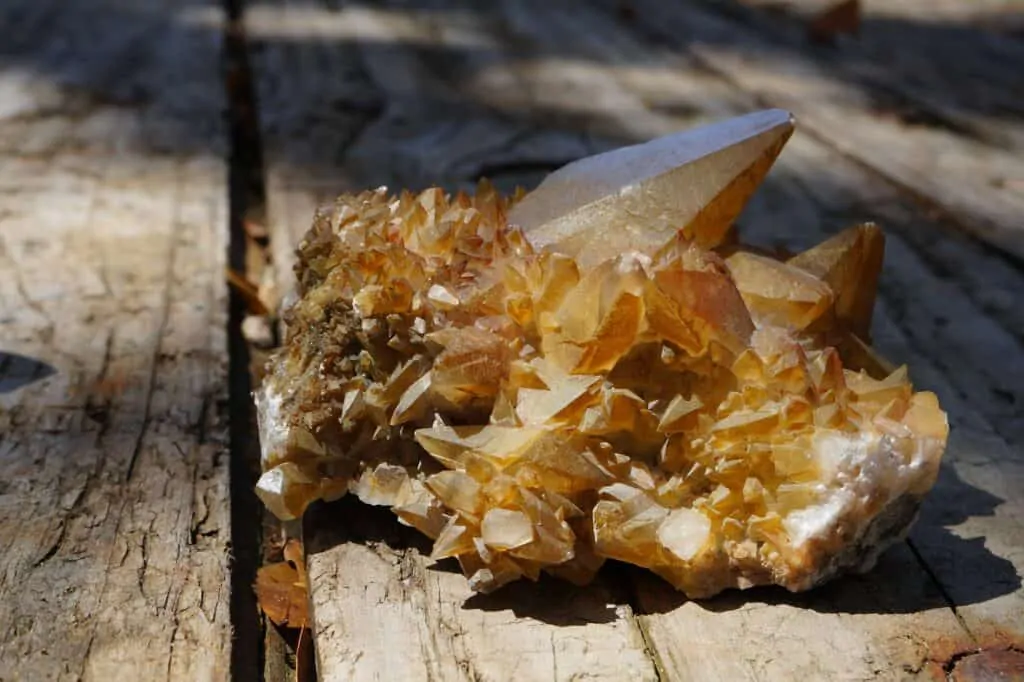
If you want to check out the best rockhounding tools, you can find them here (Amazon link).
Recreational Gem Mining Locations are Great for Crystal Enthusiasts
For those who prefer not to venture out alone and sift through rocks in unfamiliar territory, there are, fortunately, some excellent alternatives that allow you to hunt for your own crystals in areas already known to be abundant with what you’re seeking.
Recreational gem mining has been steadily gaining popularity. As a result, numerous sites are now open to tourists and gem enthusiasts that allow you to dig for your own crystals.
These locations offer a more structured and guided experience, ensuring you can find the crystals you desire without the uncertainty and potential risks of exploring unknown areas.
Crater of Diamonds State Park in Arkansas
As one of the few locations in the world where the public can search for real diamonds, Crater of Diamonds is a unique opportunity for anyone wanting to hunt for crystals. The park encompasses a 37-acre field that is the remnant of an ancient volcanic crater. Visitors are welcome to bring their own digging equipment, provided that it isn’t battery-operated or motor-powered. Alternatively, you can rent tools directly from the park for your crystal-hunting adventure. Crystal-hunting
As per the Crater of Diamonds State Park, since its opening to the public in 1972, visitors have discovered an impressive total of over 33,100 diamonds within the park’s grounds.
This remarkable figure is a testament to the park’s rich geological history and its enduring appeal to those passionate about unearthing their precious gems. With the right tools and persistence, you could join the ranks of the lucky visitors who have struck diamonds at this one-of-a-kind destination.
The largest diamond found there was the 40.23-carat Uncle Sam, which was found in 1924. More recently 2015, a tourist found an 8.52-carat diamond , so you may still have a chance of unearthing a real treasure at this state park.
You can explore the park by simply hunting for gems on the surface, digging and sifting soil a few inches deep, or digging deeper holes and strategically searching.
While you aren’t guaranteed to find a diamond, there are plenty of other small crystals, like quartz, that you can walk away with.
The park has a small entry fee but includes other amenities such as hiking trails, several camping sites, a gift shop, a seasonal water park, and a cafe.
TIP: Check out this article for a complete rockhounding guide in Arkansas .
Emerald Hollow Mine in North Carolina
Nestled in Hiddenite, North Carolina, the Emerald Hollow Mine is currently the only emerald mine in the world open to the public to search for gems. While the mine may have emerald in the name, it boasts more than sixty different types of naturally occurring gems and minerals, so it is a great place to start your quest for crystals.
Some of the more rare gems and minerals that are found at Emerald Hollow Mine include:
There are also loads of both smokey and clear quartz crystals. If you’re feeling lucky, you may unearth some truly rare specimens. As recently as 2009, two men found a massive 310-carat emerald that has been dubbed the Carolina Emperor .
The park is open from 8:30 am to sunset every day of the year except for Thanksgiving, Christmas Eve, and Christmas Day.
You can choose your method of searching, whether it be sluicing, creaking , digging, or a combination of the three. They also have a lapidary shop on the premises that can help turn rough stones into polished gems and jewelry if desired.
TIP: Check out this article for a complete rockhounding guide in N orth Carolina .
Jade Cove in California
Jade Cove is a unique location on this list because it is not part of a commercialized operation. You don’t need to pay an entry fee or rent any equipment. You can come and go as you please, but it may be a little more challenging than the previous sites mentioned.
Located as part of the stretch of the Big Sur coastline, it can be easy to miss Jade Cove. The trail to reach it is steep but fairly short, and it is known for its remarkable green cliffs.
As the name implies, Jade Cove is rich in jade. It has nephrite and jadeite, including several rare types of jade, such as botryoidal jade.
Most of the best jade is inaccessible to casual crystal hunters as it is hidden under the ocean waves, and the currents in this region are very strong, so only skilled divers can reach it.
However, waves will often wash pieces of jade onshore, and during low tide periods, it is not uncommon to find some of the stone.
If you decide to visit Jade Cove to prospect, keep in mind that local laws place restrictions on your search.
For example, visitors are prohibited from excavating or digging, and you are not allowed to collect anything deposited above the mean tide line.
TIP: Check out this article for a complete rockhounding guide in California.
TIP: Jade is the most valuable gemstone in Asian culture. The combination of jade’s history and magnificent appearance makes the stone so valuable and popular. Find out more in the article below: 6 Factors Why Jade is Valuable (+ Prices for Colors & More)
Cherokee Ruby and Sapphire Mine in North Carolina
Located in the Cowee Valley gemstone region of Western North Carolina, the Cherokee Ruby and Sapphire Mine is listed by the International Gem Society as one of the “ Top Places to Mine in the United States .”
The mine is particularly notable for having a rare type of ruby known as a pigeon-blood ruby, which is only otherwise found in Burma. Other stones that can be found at the Cherokee Ruby and Sapphire Mine include:
- Star rubies
- Star sapphires
- Star garnets
- Rhodolite garnets
- Pyrope garnets
- Sillimanite
- Clear Quartz
- Smokey quartz
You will sluice through the rocks and soil with a sieve to find your treasures at this mine. The admission fee is fairly low, and the set-up encourages family or group prospecting. You search through buckets of soil rather than searching along the ground itself.
In addition, the Cherokee Ruby and Sapphire mine doesn’t “salt” the soil like some other mines. “Salting” refers to the practice of stocking the soil with outside gems to be more appealing to visitors.
Instead, the soil is completely natural, and whatever you find truly came from the region and isn’t an artificial discovery.
Herkimer Diamond Mines in New York
Tucked away in St. Johnsville, the Herkimer Diamond Mines are a great place to hunt for crystals. It is specifically known for its abundance of Herkimer diamonds , which, despite the name, are not actually diamonds but instead a type of quartz.
However, the crystal-clear clarity of the stones makes them reminiscent of diamonds, and they are still a very popular find among crystal enthusiasts.
The mines are above surface mines, meaning you can easily search along the ground’s surface if you like or dig deeper if desired. Often, it is handy to have a hammer or chisel because many of the crystals are found by breaking open larger rocks.
You can keep everything you find, and the Herkimer Diamond Mines also has a “ Build and Wear, Build to Share ” activity center where you can transform your crystal finds into jewellery.
TIP: Check out this article for a complete rockhounding guide in New York.
Rainbow Ridge Opal Mine in Nevada
The Rainbow Ridge Opal Mine has been family-owned and operated in Virgin Valley, Nevada, since 1949. It specializes in opals, and the colours can vary from completely colourless to black. The Roebling Opal , which is currently in a collection at the Smithsonian Institution, was found at the Rainbow Ridge Mine in 1918.
The opals most commonly found in this region are referred to as “specimen only,” meaning that they aren’t suitable for being cut into jewellery and are left uncut. However, these opals can make a fine addition to any crystal collection, and their colour variations are unique and beautiful.
Opals have an underlying body colour but then have a varying level of transparency, which results in the stones being able to play with light and display shifts in colour. It gives the stones a shimmering quality and an opalescence.
Take note: if you are specifically a fan of fire opals, then the Bonanza Opal Mines in Denio, Nevada, is another great place to search.
TIP: Check out this article for a complete rockhounding guid e in Nevada .
Graves Mountain in Georgia
Graves Mountain is located in Lincolnton, Georgia, and is famous for being used as a mining location by Tiffany’s in the 1920s for finding rutile.
Now, you can visit the mountain to search for your crystal collection, but you need an appointment to visit. Also, only members of the Georgia Mineral Society are allowed to dig year-round. Those who aren’t members may only dig on a few select days in the year, but it is a free event.
The wait may be worth it, however, since the mountain is known to be rich in desirable minerals. Some gems that have been found there include:
TIP: Check out this article for a complete rockhounding guide in Georgia.
Douglas Lake in Tennessee
While a zinc vein in middle Tennessee makes crystal hunting between Carthage and Nashville highly satisfying, you might consider a winter trip to Douglas Lake in eastern Tennessee for your rockhounding expedition.
The water level in the man-made reservoir drops during the colder season to improve your chances of finding “Douglas Diamonds.”
These are not real diamonds, though. They are quartz crystals similar in clarity and quality to the Herkimer Diamonds of New York (see above).
Your best chance of finding them is to walk the lake bed looking for floats of red clay. There’s actually an app from the Tennessee Valley Authority for rockhounds who want to know when the lake levels are low enough to hunt.
TIP: Check out this article for a complete rockhounding guide in Tennessee.
Sunstone Knoll in Utah
Located in Millard Country, Utah, Sunstone Knoll is home to, as the name suggests, sunstones. Though small, you can easily gather a handful of these glittery, transparent, golden-toned crystals just walking along with the land.
For larger crystal finds, you can bring your rock hammer (and protective eyewear, of course) to search through the cavities of volcanic rock.
TIP: Check out this article for a complete rockhounding gui de in Utah .
State Mining and Mineral Departments Can Be a Good Resource
If you’re searching for crystals and unsure where to start, use the resources available from state mining and mineral departments.
These departments can provide a trove of useful information and can help guide you in your search. Most states will have these divisions and details about what gems and minerals are currently mined in your region.
Sometimes, these departments will have maps of current and abandoned mining operations. If the mine is inactive, you are usually free to explore the terrain and claim any crystals you may find.
Mining operations typically unearth large amounts of crystals, and since the mining is usually in pursuit of a particular mineral or metal, these crystals are discarded and ignored. If you visit these old mining sites, you may find substantial crystals in piles throughout the mine.
Keep in mind, however, that if you visit these sites, you should not attempt to go into any mining tunnels. These can be extremely dangerous, and you should not venture into them as you cannot know whether they are safe.
Even if your region has no abandoned mining sites, you can still utilize the information provided by state mineral departments to determine the best places to look for crystals.
Mineral departments will often provide geological maps of the state, and you can identify locations that contain rocks such as granite or pegmatite that are more likely to yield crystals.
TIP: Alluvial deposits along rivers and creeks are brilliant places for rockhounding. Check out the best rockhounding tips for finding rocks near rivers and creeks in the article below: 8 Tips On Finding Gemstones In Nature (Rivers & Creeks)
Certain Gems and Crystals are Commonly Found Around Hot Springs
Another location that often yields crystals is around hot springs and hydrothermal springs. The hydrothermal activity in these locations can form several different types of crystals and minerals . As the hot water pushes its way to the surface, it often brings along a variety of crystals.
If you are visiting a hot springs area, look for crystals such as opal, agate, and amethyst, which are usually more common in these regions. Other gemstones that may be found around hydrothermal deposits include emerald, tourmaline, and beryl.
BTW: Do you want to know more about rock and mineral identification? The books listed below are the best ones you can find on the internet (Amazon links):
- Smithsonian Handbooks: Rocks & Minerals
- Gemstone & Crystal Properties (Quick Study Home)
- Ultimate Explorer Field Guide: Rocks and Minerals (National Geographic Kids)
Areas With Volcanic Activity May Have Crystals
Volcanic activity can result in crystal formation, both directly and indirectly. So, if you have access to a region that has some volcanic activity, you may be able to find some crystals in the area.
A specific type of magma called Kimberlite is rich in minerals, including some valuable crystals, and can deposit this rich igneous rock on the surface.
Kimberlite has been known to include olivine, apatite, chromite, garnet, and even diamond. In fact, Kimberlite takes its name from Kimberley, South Africa, a region rich in diamonds.
Any region that has seen molten magma will likely have obsidian present. Obsidian is a natural volcanic glass, and it is known for its shiny black colour.
While it technically isn’t a crystal (it actually contains minimal crystal growth ), its appearance often makes it appealing to crystal collectors. It has a glossy sheen, and its colour can range from deep black to red, brown, green, purple, and even rainbow varieties.
Other gems that may be found in areas with volcanic activity include zircon, topaz, and ruby. Pegmatite deposits in the area often yield large, good-quality crystals.
TIP: Obsidian is among the most prized rocks in their collections that all rockhounds want to have. But where to find obsidian? Check out the locations in the USA in the article below: Finding Obsidian: 6 Best Locations Near Me (United States)
How Do You Know Where to Dig for Crystals?
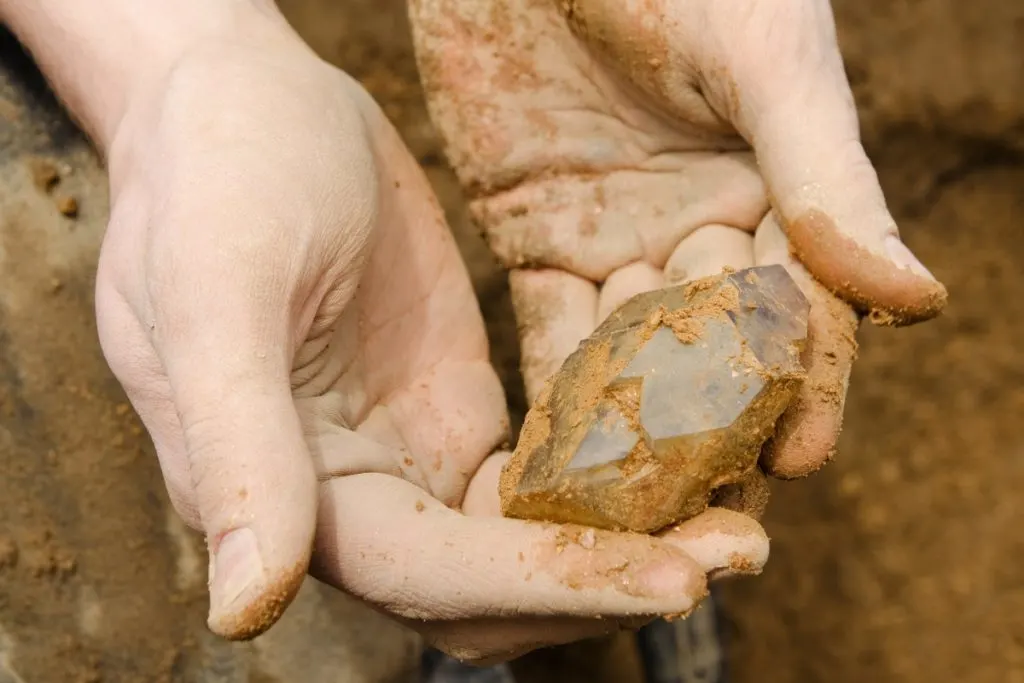
We have dug into (no pun intended) a few specific places to mine for crystals and suggestions to find areas with potential.
But let’s take a moment to talk specifically about how you determine where to search for crystals once you’ve gotten to the mining location. Why are some areas richer in gems than other areas? What makes for a good crystal-digging location?
Certain crystals will occur naturally in a much greater abundance than others, especially if you look in the right areas. For example, quartz crystal is the second most common mineral on Earth, so it is easy to find it in your search.
However, finding it in large, good-quality specimens is more challenging. If you take the time to search in certain areas, you will have a better chance of finding ideal crystals.
One place to dig for crystals like quartz is in rock veins. Veins are deposits of minerals that course through a rock, filling cracks and fissures in a way that makes the minerals look like veins running through the host rock.
If you find a few crystals on the ground, look to nearby rock formations to see if any veins are present. Crystals can be carried a fair distance thanks to forces of nature, so the original vein might be far from where the crystals are found.
Generally speaking, a location with a fair amount of crystals on the soil’s surface is a good place to start looking.
The larger the crystals on the surface are, the more likely you are to find more crystals with a little digging. Sometimes, the crystals won’t be readily visible on the surface. In this case, digging a few test holes to see if a layer of crystals is lying beneath the topsoil can be helpful.
If you see areas containing rocks with flat sides , this may indicate that crystals have formed there. Certain types of rocks are also more likely to yield crystals, so if you find areas containing these rocks, there is a better chance that you’ll walk away with some crystals:
TIP: Geodes are not simple crystals but small geological models – a tiny cave in your hands. Check out the most common crystals you can find in geodes in the article below: 16 Most Common Types of Crystals You Can Find in Geodes
Look for Rocks That Commonly Form Crystals
Certain rocks are more likely to yield crystals, so if you can locate areas with large deposits of these rocks, you will have a better chance of finding quality crystals.
For those not wanting to visit specific mining sites, this can be a great way to determine your own location to start your search for crystals.
Granite rocks are often a good bet for crystal hunters. Granite is an igneous rock that tends to be light in colour coarse, and grainy. They have a high silica content and a mixed mineral composition, often making the rock a speckled colour.
Granite is the most common igneous rock found at the Earth’s surface , so no matter where you live, it is likely that you’ve seen granite at some point in your life. It is also commonly used in buildings and monuments.
Most granite has very small crystals present, but there are sometimes pockets of larger crystal deposits in which you can find some quality crystals. The crystals you are most likely to find in granite are:
- Plagioclase feldspars
- Potassium feldspars
- Hornblendes
- Muscovite micas
- Biotite micas
- Lepidolite micas
In addition, you may be lucky to find rarer gemstones in granite, such as:
However, these gemstones are much less commonly found, and it is unlikely you will find them if you are only occasionally hunting for crystals or don’t have the proper amount of skill and expertise to locate them.
Pegmatite is another coarse, grainy igneous rock. Pegmatite is an extremely igneous rock because it contains especially large crystals, including fairly rare minerals.
To be called pegmatite, a rock must be mostly composed of crystals at least one centimeter in diameter. The actual mineral composition of the rock is not important for classification.
Because of the way pegmatite is formed, it can contain extremely large crystals. For e x ample, in South Dakota, a pegmatite yielded a spodumene crystal that was 42 feet long and 5 feet in diameter.
While you probably won’t stumble upon a crystal this large in your search, you’re still highly likely to find some substantial crystals.
Pegmatite is often rich in quartz, feldspar, and mica crystals. They also can be sources of desirable gemstones such as:
- Chrysoberyl
Another igneous rock, gabbro , is dark and grainy, usually black or dark green in colour. The crystals present in gabbro tend to be granular in size but are larger than the crystals present in basalt and tend to be over 1mm in size .
Unlike granite and pegmatite, gabbro rarely includes deposits of quartz. Most commonly, gabbro has a high percentage of plagioclase feldspar crystals. Gabbo can also contain pyroxene, olivine, and amphibole.
TIP: You may be wondering where your gemstone was originally found. Like gabbro, the most inorganic gemstones form in the Earth’s crust (the oute rmost layer) . Find out more in the article below: Which Gemstones Come From The Ocean? Corals, Pearls, & more!
Diorite is an igneous rock that has a composition that falls somewhere between granite and basalt. It is often found in locations where the edge of an oceanic plate is forced beneath the adjacent edge of a continental plate.
It commonly has a “salt and pepper” appearance, with a mix of black and white mineral components.
Like gabbro, diorite rarely includes quartz crystals. However, it usually has a fair amount of the following crystals:
- Plagioclase
Diorite is sometimes polished and used as a gemstone itself. A specific diorite with pink feldspar phenocrysts in Australia is frequently cut into cabochons and sold as “pink marshmallow stone.”
Peridotite is a group of dark-coloured igneous rocks typically containing olivine as the main mineral composition. They have a relatively low silica content, so it is rare to find quartz crystals within them, but they are prized for containing other rarer elements.
In addition to particular crystals, peridotites are considered valuable because they often contain chromite. Chromite is the only mineable source of chromium, an extremely useful element used in metal and many chemicals and manufactured products.
As far as crystals, peridotite often has fair amounts of the following:
Perhaps most notable, however, is that peridotite has often been known to contain diamonds. If you’re lucky, your search for crystals may just end with you finding a literal diamond in the rough!
Final Thoughts
Whether you are a dedicated rockhound or just a casual prospector looking to add a few crystals to your collection, there are several options for you to find your own crystals.
Finding and digging your own crystals can be incredibly satisfying and rewarding, and who knows: if you’re really lucky, you might uncover some very valuable and rare gems.
TIP: It is always good to know if it is allowed to dig for rocks in a given place. Because it is illegal sometimes. Find out more about this important topic in this article: Is it illegal to take rocks from nature? You Should Know This
Rockhounding Arizona: 12 Gorgeous Locations To Find Unique Treasures
If you are a rockhounding fanatic, then Arizona should be your first pick when it comes to finding amazing rocks.
While some are collectors’ dreams based on value, others are simply beautiful and can help to spruce up the unique look of your home.
Either way, it’s a win-win when you go on a rockhounding excursion.
When it comes to rockhounding Arizona, we’ve chosen our top 12 locations for you to explore.
The information provided in this article by YesDirt.com is for informational purposes and is subject to change. Laws are updated. Accessibility guidelines and restrictions change. Be sure to confirm the land status and collection rules before you travel to an unfamiliar location or collect any material.
Where To Go Rockhounding In Arizona
Colorado river rockhounding – gold.
Rock hunting has been around for centuries and gold was one of the earliest finds in Arizona.
Pauline Weaver found gold on the Arizona segment of the Colorado River in the early 1860s, and her discovery sparked what became the Colorado River Gold Rush.
This resulted in the formation of the La Paz Mining District, which encompassed a 20-mile radius from each side of the Colorado River starting at the actual discovery location.
The Weaver mining district was established the following year as additional sediments were discovered further down the Colorado River.
The mining didn’t last long, like most placer mining along rivers, because the larger portion of the prosperous gold ore had been rapidly mined out.
However, rock hunting experts and rookies are still able to locate gold in the Colorado River. They’ll find it in the sandbars of the river, and the gold is most often very fine.
There are several other places that you are still able to hound for gold, such as atman, Vulture Mine, Little San Domingo Placers, Gold Basin, and Greaterville.
Rockhounding Date Creek Mountains – Quartz Crystals
While quartz may be a common crystal across the globe, it is still a top choice for rockhounding in Arizona. This is because you are guaranteed to find amazing specimens that are nicely crystallized in this area and its environs.
Luckily, there are many excellent areas in Arizona where you can do your rock collecting and acquire very lovely samples.
One of these sites is the Date Creek Mountains. While this zone has been heavily exploited over the decades, there are still some nice parts to be found.
You could get fortunate and come across a lovely specimen on the surface while wandering about. However, the finest specimens are discovered by those willing to search. Scan for abandoned holes and start digging.
Another place with lovely quartz crystals is Diamond Point, northeast of Payson.
This location is at a higher altitude but rock hunting enthusiasts are not bothered by this usually.
New crystals can be exposed by rainstorms, but you’ll certainly discover the perfect ones when you get grimy and dig.
The slopes north of Aguila are a famous harvesting spot. Throughout this place, people can find decent discharged quartz crystals.
Crystal Hill, slightly southeast of Quartzsite, is among Arizona’s increasingly common crystal collection spots.
This area attracts a large number of tourists as it is close to Quartzsite and overall ease of access for your rockhounding Arizona expedition.
Since it takes effort to find good quartz, there are still some available. Optimistic rockhounds that are capable of following the edges and pick beautiful crystals out from the rock layers discover the perfect bits.
Rockhounding Hauser Geode Beds – Geode
Here is another popular area for rockhounding Arizona excursions.
If you’re passionate about geodes, this is the place of choice where you’re sure to find tiny and large geode stones when you’re rock collecting.
The beds were discovered back in the late 1930s by Joel Hauser, a Blythe native who used his small Ford truck to explore the hills and collect gems.
It is situated off Interstate 10 and Wiley’s Well Road South, approximately one hour to the south of Blythe on both paved and rough terrain.
Jump into your 4×4, and travel until you get to Coon Hollow campground. (A high SUV or other trucks can work too).
Turn right on this dirt road when you see a sign for Hauser Geode Beds. It is inconsistent and gets rough at some points.
The Hauser Geode grounds, which have been famous to rock enthusiasts for several years, have created some quite spectacular geodes of numerous forms.
Amethyst crystals border certain geodes, while white or black calcite crystals cover plenty. A geode is a mineral in the form of a sphere with a crystal-lined cavity.
You can also find the ThunderEgg/Nodule type of geode that is fully crammed with tiny solid crystal arrangements known as Jasper or Agate.
Other places to find geode are the Straw beds and the Potato Patch. Diggings can be found on the sides of the hills, where you can rummage through the green ash for geodes.
You can also take a trek and find geodes scattered about, even though they might not be of the highest quality.
What To Take With You
When rockhounding in the wilderness, you should try to be fully equipped: pick and shovel to dig the hole, a hammer to break the rocks, and some buckets, as well as the usual desert necessities, such as plenty of water, food, a first-aid kit, mobile phone maps, and anything else you feel necessary that doesn’t add too much weight.
Rockhounding Saddle Mountain – Fire Agate
Saddle Mountain is a famous rockhounding destination just next to Queen Creek, particularly for those looking for fire agate, a semi-precious jewel found only within Arizona and some other southwestern regions.
The fire agate found in the Saddle Mountains is of high caliber and will complement your mineral inventory.
There are several points to consider when you’re engaging in rockhounding in Saddle Mountain.
For starters, Saddle Mountain is home to many private mining claims, so make sure you’re exploring in a public space and not on someone’s land.
Furthermore, since Saddle Mountain has attracted so many rockhounds over the decades, you’ll need to be patient if you’d like to locate fire agate.
The ideal opportunity to delve for that kind of gemstone is immediately after a downpour.
Rockhounding Round Mountain- Chalcedony Samples
People may surely access chalcedony samples, such as agate and often a variety of minerals, whenever they explore this rockhounding place.
They might be able to wiggle a geode out from the rocky terrain with some effort.
Once you’ve had your limit of rockhounding, take a stroll on some of the pathways that snake through the region, or pitch a tent so you can drill down early the next day.
Rockhounding Bear Hills – Jasper
Jasper is one of the most plentiful and widely distributed minerals in the state of Arizona.
Some of these sweet jaspers can be found in the Bear Hills, just east of Brenda, and they can often display nice orbicular patterns.
This is a perfect place to hunt for quality specimens because there are so many color variations.
Jasper is a popular choice among rockhounds since it is tough and polishable. You may use it to make jewelry by putting it in a stone tumbler or cutting it into cabochons.
The majority of jaspers are strong dark colors. Select bits, on the other hand, will have pleasant banding and color variance. That’s just what you’re looking for!
Other areas to find Jasper is the Plomosa region, southwest of Bouse, and Yuma south of the Quartzsite. You may get lucky and find both gold and agate as well.
All you need are your boots because Jasper is abundant.
Rockhounding Apache Tears Caves – Apache Tears(Obsidian)
This wash absorbs run-off from the surrounding hills, and as a result, it’s brimming with Apache Tears , which are Obsidian nodules.
Merikanite Obsidian is a semi-precious rock. It is a type of natural glass with conchoidal contours (convex on the outside, concave on the inside), with nodules ranging in size from peas to a tennis ball.
You will quickly locate the stones by following the scores as you walk along the sandy area. Since there are so many of them, you’ll quickly become picky on what to collect.
Apache Tears are only formed near Superior, Arizona, and when refined and held to the light, these are semi-transparent and have a smoky brown shade.
The only obsidian nodules known as Apache Tears are those found in the region.
Obsidian is a volcanic glass made mostly of Silicates, but it contains a diverse range of elements, making it a rock rather than a mineral.
The rock is made up of cryptocrystalline Silica minerals suspended in a glassy suspension, which forms when magma is supercooled.
Obsidian is produced at the end of basaltic eruptions when the expelled mainly Silicates are rapidly cooled at surface temperatures.
Why Are They Called Apache Tears
Legend has it that several apache warriors jumped to their deaths rather than be defeated by members of the military. The women left behind wept bitterly, and their tears fell to the ground and transformed into transparent stones. ( source )
Rockhounding Golden Valley – Agate
Between Kingman and Oatman, the Cuesta Fire Agate Mine can be found when you exit Route 66. Since 1902, the location of this mine has consisted of four 20-acre claims held by one family.
The ability to dig for a fee is available at this mine. As a visitor, you can pay a fee then hire equipment to mine the claim for a day for a small fee. The diggers will hold anything they find, up to the size of a bucket, no more than five gallons per day.
Don, the proprietor, explains how Fire Agate is shaped and provides tips on how to search for, find, and excavate fire agate from the host rock.
Some visitors have come across Chalcedony (Desert) Roses as well as Druse Crystal Clusters.
You’re able to trod along the claims for 30 dollars a day and salvage whatever you discover on the land.
Rockhounding Arizona Location: 9049 Oatman Rd (Old Route 66), Golden Valley, AZ 86413
Rockhounding Fountain Hills – Amethyst
Sami Fine Jewelry offers Amethyst Mine Tours on a regular basis, allowing guests to get up close and personal with the Arizona Four Peaks Amethyst.
The mine is reached by helicopter for visitors.
The guests meet and interact with the mine owner, Kurt Cavano, as well as the miners once they arrive. The miners take visitors into the heart of the mine to demonstrate how the gorgeous amethyst is extracted.
Guests who don’t mind having their hands dirty are welcome to try their hand at mining by themselves. However, space is restricted, and reservations are needed.
The tour lasts for six to eight hours and will cost a group of four people a total of $2,700. You are transported back to the starting point once you’ve seen the finishing process for the Amethyst production.
Location: 16704 Avenue of the Fountains #100, Fountain Hills, AZ 85268
Rockhounding Flagstaff – Gem Variety
Throughout the months of June to August, the Environmental Education Center in Willow Bend provides free supervised downtown geology excursions of Flagstaff two times each month.
These one-hour walking tours are established on the book Stone Landmarks, written by Marie Jackson, a local-based author in Flagstaff.
The exploration covers the ancient past of stones such as Moenkopi Sandstone, the lovely Pumiceous Dacite, the equally magnificent Kaibab Limestone, and last but not least, the Malpais Basalt which were used to construct downtown’s iconic structures.
The tour furthermore emphasizes the evolution of architectural techniques, shifting tastes for different forms of rock, and historic occurrences.
Participants will look for fossils along the walls of the Ice House, learn about “Arizona Red” stone, explore the depths of the “Grand Canyon” at Heritage Square, and see elegant rock etchings, among other things.
Location: 24 N San Francisco St, Flagstaff, AZ 86001
Rockhounding Littlefield: Variety Of Gems
The Land Management Bureau approved the recreation area of Virgin River as a rockhounding expanse on municipal property. Petrified wood mineral specimens, minerals, semi-precious stones, as well as invertebrate fossils can all be found here.
Each individual is allowed to gather as much as 25 pounds of material each day and 250 pounds per year for non-commercial intentions.
On public property, you do not collect historical objects like pottery, rock art, or arrowheads, or vertebrate fossils like dinosaurs, mammals, or fish.
Rockhounds have access to a campground that is available at this location. Sixteen miles northeast of Littlefield, AZ, is where you’ll find the rockhounding area. Take exit 18 off Interstate 15
Location: Littlefield, AZ 86432
Quartzsite: Gems, Rocks, And Fossils
This Two-week Camping Zone at Dome Rock Mountain is ideal for rockhounding Arizona— Just like Littlefield, The Land Management Bureau appointed this public property as a rockhounding field.
Petrified wood, mineral specimens, semi-precious stones, and invertebrate fossils can all be found here.
Each individual is allowed to dig up a maximum of twenty-five pounds of material per day and 250 lbs in total annually. It can only be collected for non-commercial objectives.
On public property, you are unable to collect historical objects like earthenware, rock sculpture, or arrowheads, or vertebrate fossils such as dinosaurs, any mammals, or fish.
There is a large camping zone accessible at this public rockhounding spot.
Location: 2995 Dome Rock Rd W, Quartzsite, AZ 85346
Overall, rockhounding is the right pursuit for you if you’ve often been intrigued by the natural deposits in Arizona’s soils. Rockhounding is ideal for the whole family but remember to carry adequate water, food, and a map.
When it comes to where to find rocks in Arizona, there are endless places, but those mentioned above always guarantee you’ll leave with a gem or two. You can start or contribute to your rock array by visiting any of these fantastic rock hunting locations.
Arizona Rockhounding Resources
If you like to have a physical book in hand (like when there’s no cell service), here’s a few popular options:
Rockhounding Arizona: A Guide To 75 Of The State’s Best Rockhounding Sites
Gem Trails of Arizona
Southwest Treasure Hunter’s Gem and Mineral Guide
Disclosure: These are links to Amazon. As an Amazon Associate, I may earn a commission from qualifying purchases at no additional cost to you.
We’ve created an ultimate guide to gifts for rockhounds with helpful links directly to Amazon to make product evaluation and review easy!
You might also like:
- Where To Find Geodes In Arizona
- Looking For Chrysocolla In Arizona
- Rockhounding Near Yuma
- Rockhounding Near Tucson
- Turquoise Hunting In Arizona
- Exploring Lava River Cave (Arizona)
- Types of Rocks Found In Arizona
- Saddle Mountain Rockhounding
- Rockhounding Burro Creek
- Where to Find Flint in AZ

OceanViewMine.com
Home of the original (tm) dirty girls rock and old guys rock merchandise.

- Trip Finder
- Newsletter Signup
- Request a Call
- Crete Sea to Summit
- Best of the Swiss Alps
- Exploring The Jungfrau
- Italian Dolomites
- Best of the French Alps
- St Moritz to Italy
- Exploring Croatia
- Italian Lakes Discovery
- Best of Slovenia and the Julian Alps
- Tour of the Giants
- Italian Dolomites Alta Via 1
- Chamonix-Zermatt Haute Route
- Deluxe Haute Route
- Deluxe Tour du Mont Blanc
- Via Alpina - Swiss Alpine Route
- Deluxe Bernese Oberland Traverse
- Eiger to the Matterhorn
- England Coast to Coast
- Scenic Alps by Rail
- Cheese, Chocolate, & the Alps
- Self-Guided - Scenic Alps by Rail
- Self-Guided- Glacier Express
- Christmas in Switzerland
- Scenic Alps by Rail - Christmas Edition
- Self-Guided Haute Route
- Self-Guided Tour du Mont Blanc
- Self-Guided Jungfrau
- Self-Guided Via Alpina
- Self-Guided Bernese Oberland Traverse
- Self-Guided Eiger to the Matterhorn
- Self-Guided Swiss Alps
- Self-Guided Austria Zillertal Alps
- Private Guided and Custom Trips
- Appenzell -Alpstein Range
- Zermatt and the Matterhorn
- Leukerbad -Thermal Hot Springs
- Principality of Liechtenstein
- Saas-Fee - Pearl of the Alps
- Tour Calendar
- Where We Stay
- How We Travel
- FAQ – Alpenwild Experience
- FAQ - Tour du Mont Blanc
- FAQ - Haute Route
- FAQ - Alps Hiking Tours
- FAQ- Scenic Alps by Rail Tour
- A Self-Guided Tour FAQ
- Self-Guided FAQ - Haute Route
- Self-Guided FAQ - Tour du Mont Blanc
- Self-Guided FAQ - Rail Tours
- Travel Agents + Alpenwild
- Why You'll Love The Alps
- Packing List – Alps Trekking Tours
- Packing List – Alps Hiking Tours
- Packing List – Alps Walking and Sightseeing Tours
- Packing List - Winter Tours- Christmas in Switzerland
- Weather In The Alps
- Haute Route Essentials
- Tour du Mont Blanc Essentials
- Is a Self-Guided Trip for me?
- Car Travel in Switzerland
- Maps & Books
- Book Your Trip
- Make a Payment
- Why Choose Alpenwild
- The Alpenwild Story
- Guides and Trip Leaders
The Secrets of Crystal Hunting

There are many crystal hunting secrets. When I meet crystal hunter Jean-Franck Charlet in his house in the Chamonix Valley, my biggest question, of course, is where, in the immeasurable amount of granite, you can find those precious minerals? The French crystal hunter uncovers the secrets of his profession without any hesitation:
Step 1. Find a crystal oven
“Crystals were once formed about ten kilometers (32,808 feet) beneath the ground. Due to the rise of the Alps, you can now find them on mountain walls in so-called crystal ovens. Such ovens are located in horizontal crevices on rock walls, and especially in those crevices where the veins in the rock are filled with quartz. Due to the white color of the quartz, these crevices are easy to recognize, making the crystal ovens in the Mont Blanc range reasonably easy to find. However, this is terrain for alpinists: the ovens are usually located in steep and extremely unstable terrain. “

Step 2. Extract the crystals
“Once you have found an oven, the real work begins. Chopping out the crystals at thousands of meters of altitude is difficult, especially when working with ice-cold fingers. The ovens are often frozen, particularly on the north side of the mountain. To free the crystals from the ice, we can use gas burners or salt, but you have to be very patient, because if you go too fast, the crystals will burst because of the sudden heat. Sometimes extracting the crystals is so much work that we spend the night on the rock face.”

Step 3. Carry the crystals down without damaging them
“This is perhaps the most dangerous part of crystal hunting. It means spending hours abseiling and scrambling over glaciers and loose rock debris with a backpack of at least 40 kilos, crammed with crystals. Even as soon as we leave the steep walls and glaciers behind us and walk on a hiking trail, tripping can be fatal. That is why you need a lot of energy for the descent and an extraordinary concentration. That’s why you look for crystals with your best friends, because you take huge risks. It only works with people you feel safe with.”
Step 4. Cleaning
“Once at home, the crystals have to be cleaned: you take a bucket of water and then brush them gently with a toothbrush. This is a magical and delicate moment, because this is when you really can see what you have found and estimate its value. In the winter, as soon as the season is over, we go to trade fairs to show our pieces and possibly sell them.”
There you have it: the crystal hunting secrets. You may be tempted to venture and hunt for crystals yourself. However, ensure you have an expert crystal hunting guide – they will use their expertise to guide you and will have a more thorough understanding of local crystal hunting laws and standards. Safety is the number one priority when crystal hunting.
This interview is the final part of a series about the crystals and crystal hunters of Mont Blanc :
Mont Blanc Crystals
Hunt for Mont Blanc Crystals
Portrait of a Crystal Hunter
- Recent Posts

- The Alps: A Biodiversity Treasure Trove - December 10, 2020
- Flora in the Alps – Spotlight on the Alpenrose - June 25, 2020
- Tour du Mont Blanc Hightlight: The Contamines-Montjoie Nature Reserve - May 21, 2020
Interested in reading more content like this? Click subscribe to receive an email when a new post is published.
Leave a Reply
Your email address will not be published. Required fields are marked *
XHTML: You can use these tags: <a href="" title=""> <abbr title=""> <acronym title=""> <b> <blockquote cite=""> <cite> <code> <del datetime=""> <em> <i> <q cite=""> <s> <strike> <strong>
Save my name, email, and website in this browser for the next time I comment.
Blog Categories
- Wildlife and Nature
- Sightseeing and Exploring
- The Via Alpina Hiking Trail Archives
- Snowshoeing
- October 2023
- August 2023
- January 2023
- November 2022
- January 2022
- November 2021
- October 2021
- September 2021
- February 2021
- January 2021
- December 2020
- November 2020
- October 2020
- September 2020
- August 2020
- February 2020
- January 2020
- December 2019
- November 2019
- October 2019
- September 2019
- August 2019
- February 2019
- January 2019
- December 2018
- November 2018
- October 2018
- September 2018
- August 2018
- February 2018
- January 2018
Sign Up for Our Email Newsletter
Stay up to date on the latest Alpenwild news. You're free to opt out at any time.
See our Privacy Policy.
Bone Valley Fossil Farm
Megalodon Shark Tooth Fossils and more!
For the best Megalodon shark tooth fossil hunting in Florida! Water based fossil hunting on land. Adults are provided with a hose to wash the fossils out of the fossil matrix. Some of the types of shark teeth you will find include Lemon Shark, Tiger Shark, Bull Shark, Mako, Snaggletooth Hemi, Hammerhead, Sand Tiger, and you may even find the elusive Megalodon Shark Tooth! Located in Bowling Green, Florida
To inquire or make a reservation, send us a facebook message or , email ( [email protected] ) to schedule your adventure with us .
To make a reservation or if you have any questions, please email [email protected]
or contact us through facebook messenger.
Upcoming Availability
We schedule digs
Thursday, Friday, Saturday & Sunday
8am to 230pm.
6.5 hours, $220.00 (inc tax) per adult, c hildren 17 and under are free with paid parent/guardian. They will share the hose & space provided for the adult(s).
Information
The original Bone Valley Fossil tour at Bone Valley Fossil Farm. Water assisted land-based hunting. Each adult is provided with a hose to assist in washing the fossils out of the matrix material. Our property is located just off US-17 in Bowling Green, Florida, 33834.
Recent Finds 2024
How to book your Bone Valley Fossil Farm fossil hunting tour: Simply send us a message or email ([email protected]) stating your preferred date(s), Number of Adults and their names, number of children and a contact phone number. We do not take deposits or payment in advance, just payment in cash only when you arrive. We will confirm availability and send you detailed instructions.
Pricing and Schedule Information.
The original Bone Valley Fossil tour at Bone Valley Fossil Farm . Water assisted land-based hunting. Each adult is provided with a hose to assist in washing the fossils out of the matrix material. Our property is located just off US-17 in Bowling Green, Florida, 33834. Premium Bone Valley “wet” hunting ••Please review information before booking••
To inquire or make a reservation, send us a Facebook message or email ( [email protected] ) to schedule your adventure with us!
Rates effective November 15, 2022
Facilities-On-site Portalet.
Current Dig Days are Thursday, Friday, Saturday & Sunday.
8:00am to 2:30pm, $220 per adult (tax Inc).
Each adult is provided a water hose to wash the fossils out of the material. Children 17 and under are free with paid parent/guardian. They will share the hose & space provided for the adult(s). Dress to get muddy and have fun! Bringing change of clothes are strongly suggested.
Military Discount - To show our appreciation for your service we offer a $20.00 discount on all non-discounted (Specials) hunts for active or former Military. Please inform us when booking. Appropriate credentials are required to receive discount. Thank you all for your service!
•••At this time, we only accept cash. Please be sure you have cash payment with you at the meet location•••
What we suggest to bring for your Adventure:
~Sunscreen/bug spray ~bottled water ~lunch/snacks ~change of clothes ~Towels ~hats ~neoprene booties or regular socks ~chairs ~umbrella/shade canopy ~containers/bags for your treasures ~cash payment
***We do have sifters and shovels available to use, but you can bring your own if you prefer!
•You WILL get wet & dirty. You’re adding water to matrix material and that leads to muddy conditions. *Please note we are unable to guarantee that you’ll find a megalodon tooth. Provided material is NOT seeded. We dig straight from the fossil layer, and we can’t control what may or may not be present. No refunds will be given. Fossils including shark teeth will be found. We reserve the right to refuse service. We look forward to digging with you and your family!
Link for More HISTORY

37 Fantastic Sites To Find and Dig For Crystals In Missouri In 2024
By Dr. Keith Jackson - Geology PhD
| Updated January 12, 2024
Updated January 12, 2024
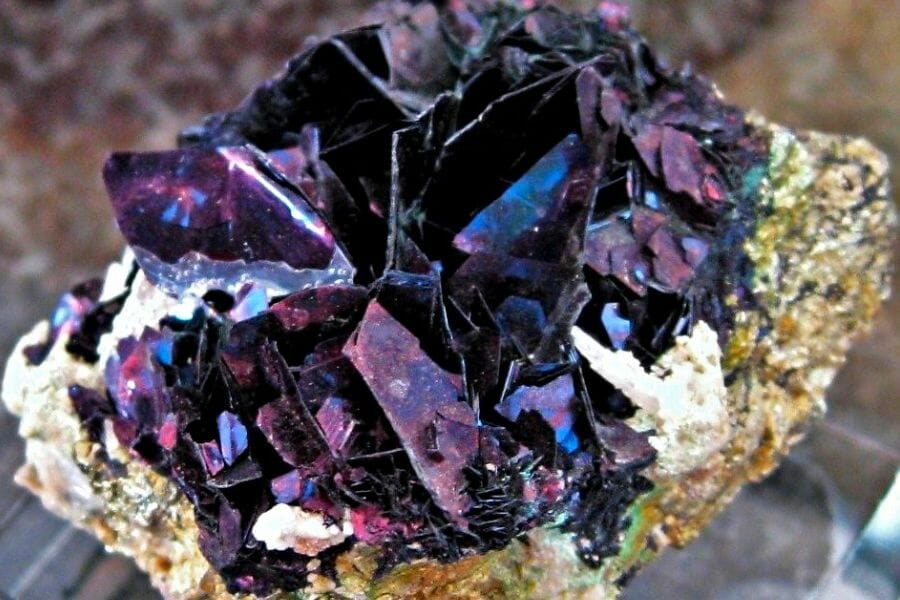
Crystals have a mystical quality that makes them fascinating to many people— the way they refract light and the intricacy of their formations make them incredibly beautiful to look at. Finding these wonders can be an exhilarating experience, but it can also be a challenging one.
For instance, finding crystals in Missouri can be difficult without the right guidance. So we’ve gone all over our state to find the best spots to find crystals: Finger Lakes State Park, Grindstone Creek, Chariton River, Rueppele Mine, and even an entire county, Cole. So if you’re up for an adventure, grab your gear and join us in our best crystal hunting locations!
- The extensive local experience and understanding of our team
- Input from multiple local crystal hunters and crystal collecting groups
- The accessibility of the crystal mining locations
- Safety and potential hazards when collecting
- Private and public locations
- A desire to include locations for both experienced crystal hunters and those who are just starting out
What We Cover In This Article
The Types of Missouri Crystals You Can Find
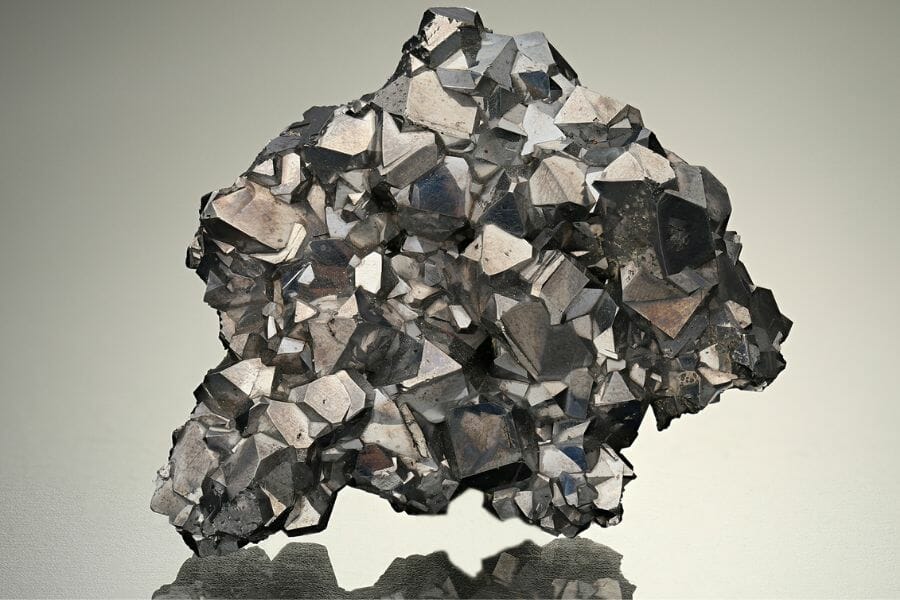
Often admired for their unique shapes, colors, and ability to refract light, Missouri crystals are found in several locations. But before you visit any of these places, you may want to know first what kinds of crystals you might find there. Here’s a great list of the crystals our state boasts of having:
Rare crystals found in Missouri
More common crystals found here.
- Chalcopyrite
The Best Locations For Crystal Mining in Missouri
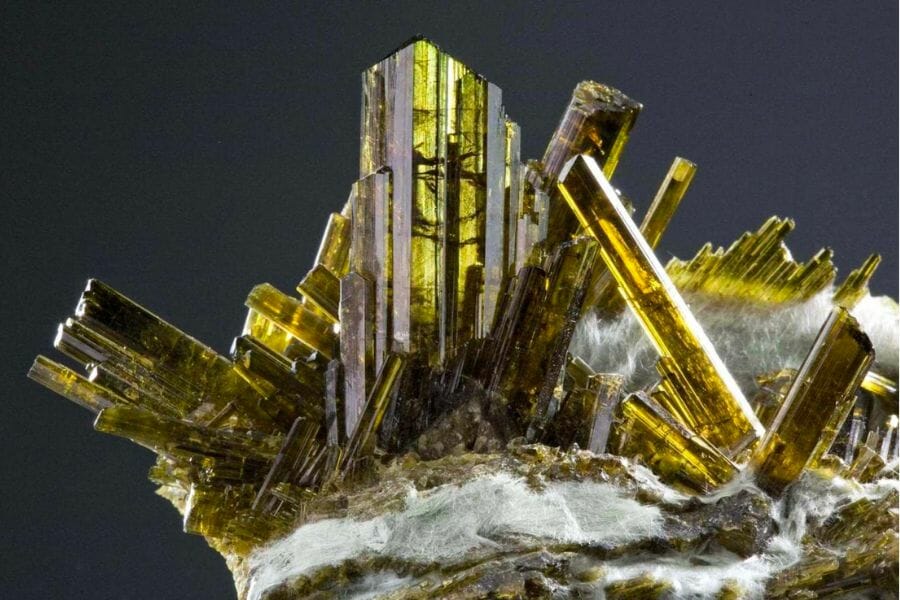
First, we’ll share with you our top recommended crystal mining sites here. We had the best of time and luck locating these natural wonders in these places:
Always Confirm Access and Collection Rules!
Before heading out to any of the locations on our list you need to confirm access requirements and collection rules for both public and private locations.
These requirements are subject to change without notice and may differ from what we state below.
Always get updated information directly from the source ahead of time to ensure responsible rockhounding.
Finger Lakes State Park is Our Favorite Crystal Mine in Missouri
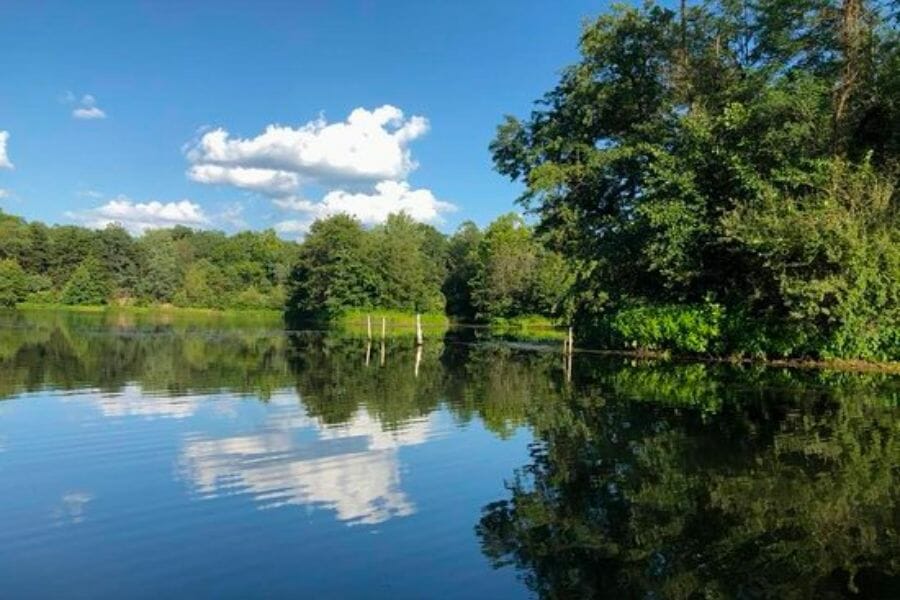
Columbia, MO
Finger Lakes State Park was once a strip mine for coal, but it has since been reclaimed and turned into a beautiful park with crystal formations scattered throughout. This history of mining makes it a unique spot to search for crystals. Actually, it’s also one of the best places to find Missouri gems !
Located in Boone County, the state park is home to several small lakes and ponds. The crystal formations here can be found in exposed rock formations and in the soil around the lakes.
If you want to go here, you’re in luck because the park is easily accessible with plenty of parking and well-maintained trails. Plus, the crystal formations are plentiful and easily visible, so even beginner rockhounds can have success here.
Where we found crystals at Finger Lakes State Park
As a former strip mine, you can find some of the best samples of Aragonite, Marcasite, Pyrite, and other crystals on the northern part of the state park.
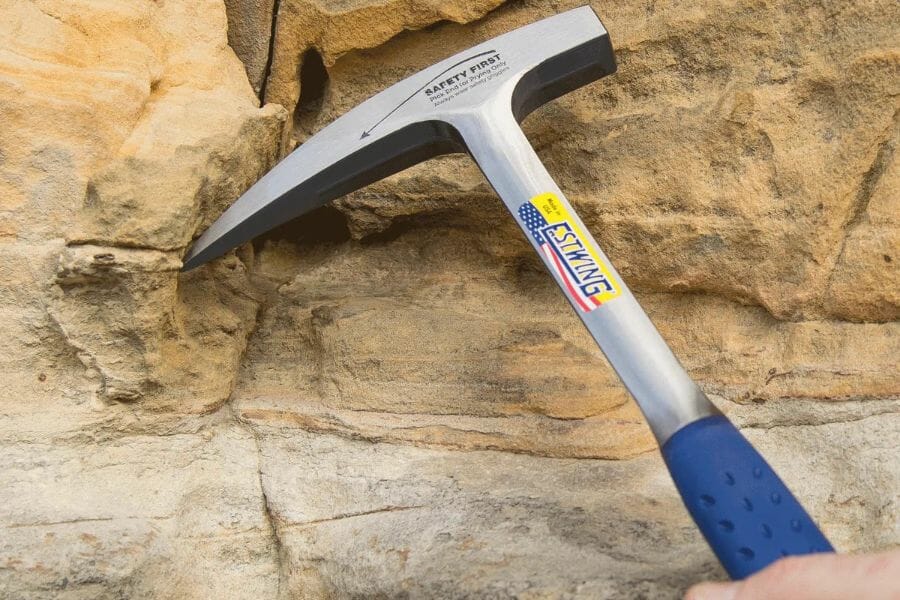
The tools every crystal hunter will need
When you're out looking for crystals having the right tools for the job is very important. You don't need a lot for most trips but there are a handful that are critical and will make your life a lot easier.
We get asked a lot about the equipment we use. Over the years we've found a handful of tools that we recommend to both new and experienced crystal miners which we outline in great detail in our complete rockhounding equipment guide . These are quality options that also happen to be relatively inexpensive.
Below are the basic tools that make your life so much easier and save you a ton of time. Check out the full guide to see everything we recommend bringing. One quick note, as an Amazon Associate I earn from qualifying purchases but we try very hard to only recommend gear we would use ourselves and often recommend brands you can't find on Amazon.
At a minimum you should have:
1 - Sturdy rock hammer : The Estwing Rock Pick is our standard
2 - Rugged chisels : Try Kendo' 3-piece Chisel Set
3 - Compact shovel : The Koleiya 28-inch shovel works well
4 - Rock screen pan : The Wazakura Soil Sieve Set fits the bill
5 - Eye protection : DeWalt Safety Glasses are cheap and comfortable
6 - Head protection : Malta's Safety Helmet has been our go-to
7 - Jewelers lens with at least 20x magnification : Jarlink's Jewelers Loop is perfect
The crystal-finding books that we use most
There are also a few books that have been extremely helpful in the search for gems. These books have great recommendations and tips:
National Audubon Society Field Guide to Rocks and Minerals: North America
Southeast Treasure Hunter's Gem & Mineral Guide
Earth Treasures: The Southeastern Quadrant
We provide links to find these tools on Amazon but some can also be found at your local hardware stores. For more recommendations check out the link to our full tool guide above.
Grindstone Creek
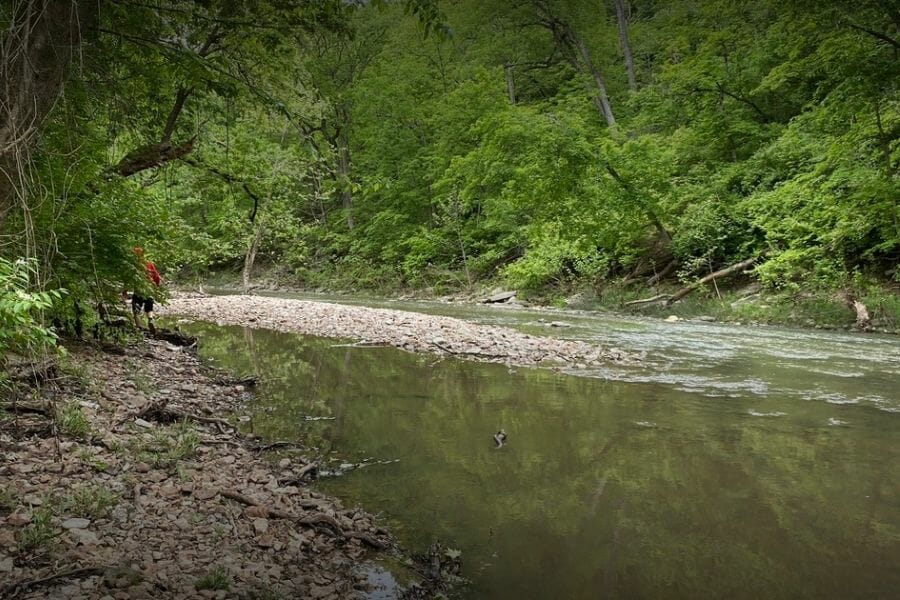
2011 Old 63 S. Columbia, MO 65201
Located near Columbia, Grindstone Creek was once a popular spot for Native American tribes to gather and trade minerals. Today, it’s a popular destination for rockhounds looking for crystals.
Flowing through a forested area with exposed rock formations, the creek and its surrounding areas are rich with different crystals. What’s best is that the creek is shallow and slow-moving, making it easy to navigate while searching for crystals.
When you visit Grindstone Creek, be sure to bring a sturdy rock hammer, chisels, and eye protection. You’ll also want to dress for the weather and wear sturdy shoes for hiking around it.
Where we found crystals around the Grindstone Creek
You can find the best samples of brown and white Calcite crystals if you explore the coal measures in the northwest portion of Grindstone Creek. Read our pricing guide if you’re wondering how much are crystals worth .
Chariton River
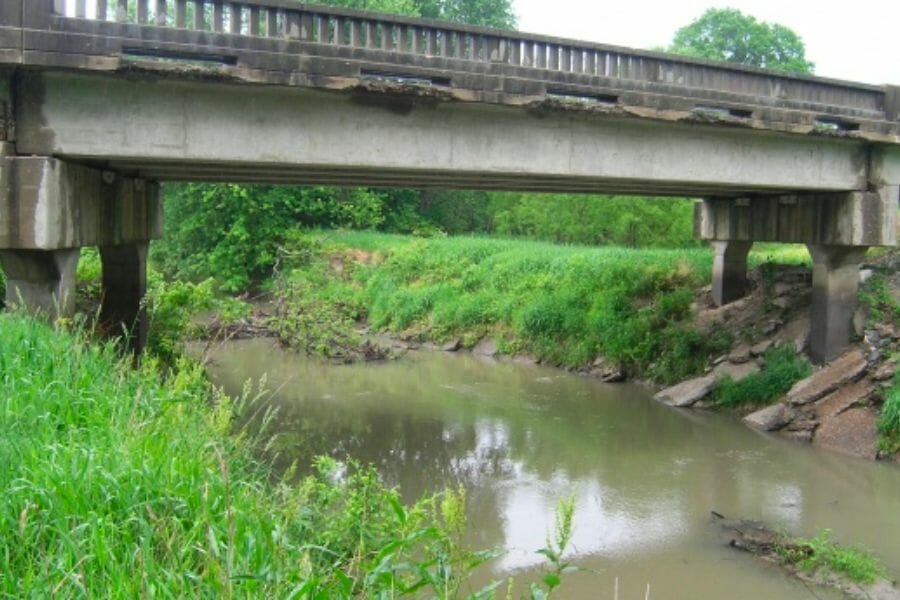
Chariton County, MO
The Chariton River has a rich history of being a valuable resource for early settlers. It’s been used for transportation, irrigation, and even powering mills. Today, it’s become a popular spot, not only for the usual outdoor recreation, but also for crystal hunting opportunies.
This location is known for its gravel bars that have been formed by the river’s flow over time, which has created an ideal environment for crystals to form and settle. And the best news is that the gravel bars are easily accessible and visible, so even beginner rockhounds can have success here.
If you want to visit here, be ready with the proper tools and equipment to find crystals. More importantly, be prepared to have an awesome crystal hunting adventure that you will remember for a lifetime!
Where we found crystals at Chariton River
We successfully found samples of Calcite and Quartz crystals in the Chariton River 2 miles north of the Macon County line, so we highly recommend you visit it, too.
Cole County
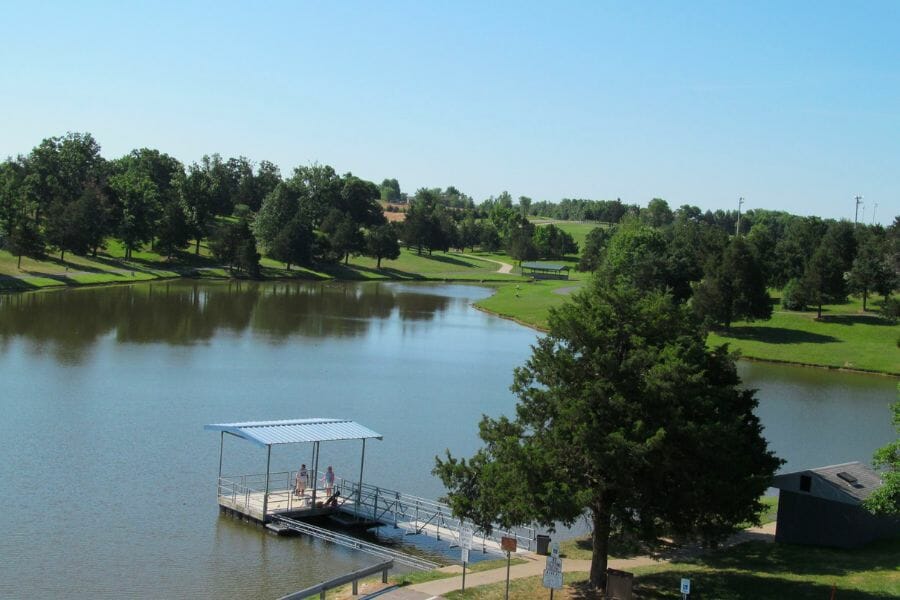
Cole County, MO
Located in central Missouri, Cole County has a rich history of mineral mining. In fact, its state capital of Jefferson City iwas once a hub for lead and zinc mining. Today, the area is home to several abandoned mines and quarries that are popular spots for crystal hunting.
The terrain in this county is hilly and rocky, which provides an ideal environment for crystals to form and settle. Some of the most popular spots for crystal hunting in Cole County include the Brewer Quarry and the Bonnots Mill Cave.
Since the area has a rich history of mineral mining, there are plenty of spots to search for crystals here. Additionally, its rocky terrain makes for a picturesque location to enjoy while you search for treasures. And, since Cole County is located in the heart of Missouri, it’s easily accessible from many parts of our state.
Where we found crystals at Cole County
There are a handful of different crystals you can find in this county: Calcite, Chalcopyrite, Hematite, Galena, Malachite, Pyrite, Quartz crystals and more if you explore the many regional mines here.
Rueppele Mine
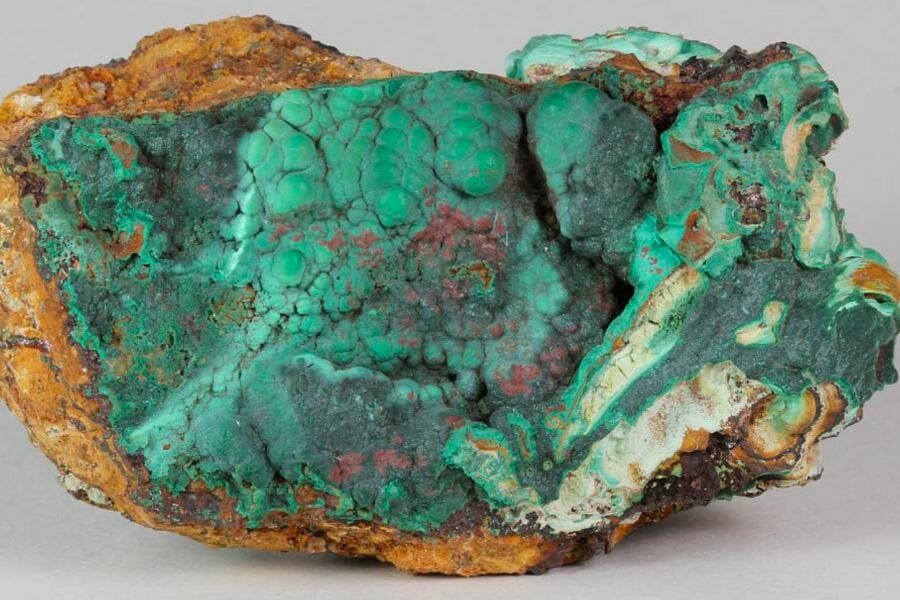
Stanton, Franklin County, MO
Rueppele Mine is located in Maries County and was once a working lead mine in the late 1800s. While it’s is no longer in operation, it’s become a popular spot for rockhounds to search for crystals. The terrain around the mine is hilly and rocky, which provides an ideal environment for crystals to form and settle.
With its rich history of lead mining, the Rueppele Mine has plenty of pockets to search for crystals.Being in a more remote part of our state, you’ll also likely have a more peaceful and quiet rockhounding experience here.
Overall, the Rueppele Mine is a must-visit for crystal hunting here in Missouri!
Where we found crystals in Rueppele Mine
Since this is a mine, if you’re here, there’s a high chance you’re already near a crystal! Some of the best ones you can find are Amethyst, Azurite, Copper, Hematite, Marcasite, Pyrite, and Quartz crystals.
Our Other Favorite Places For Crystal Hunting
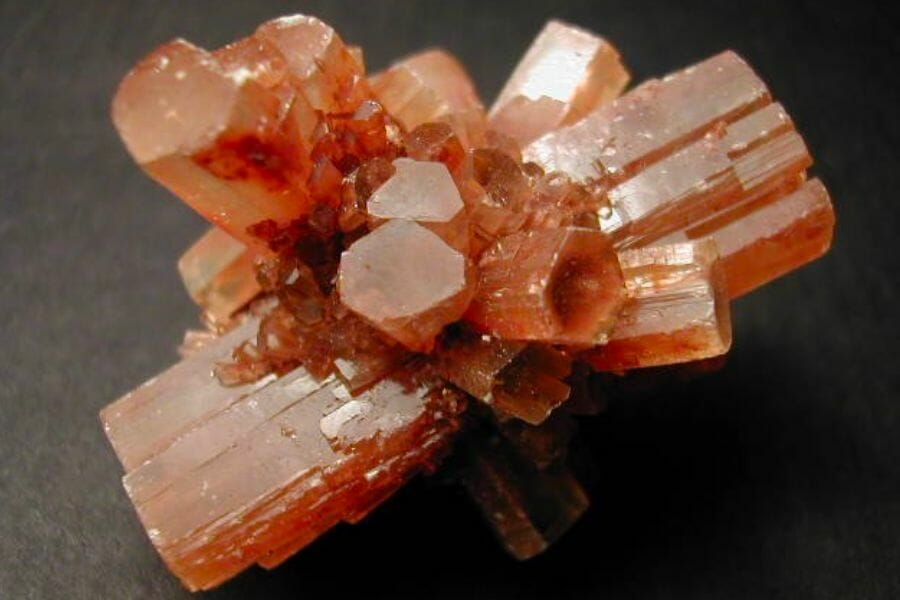
It’s no secret that our state is rich with different natural wonders, so it should come as no surprise that there are plenty other great places to do crystal hunting here. Some of these are also great places to find geodes in Missouri :
Where you can find crystals for free in Missouri
More often than not, the best places where you can find crystals require some fee. But there are plenty others where you don’t have to spend a dime. Here are some of them:
Other great places to dig for crystals
If you’re open to pay a few bucks to find crystals, below is a list of some of the best pay-to-dig mines here. Remember, these fees may vary depending on the season (on some occasions, they might even be free!) so reach out first before heading out.
How to find crystals in Missouri
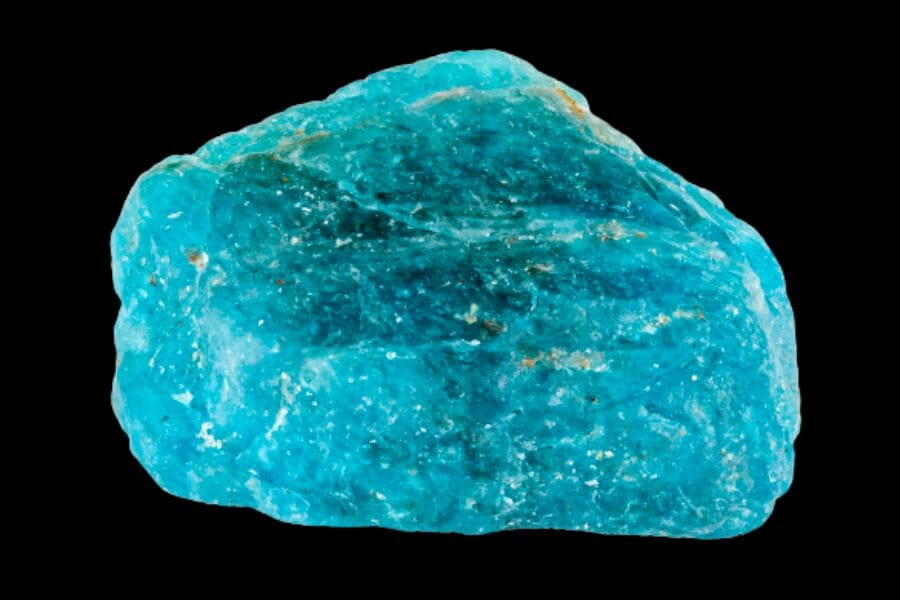
A handful of our recommended places above cover wide areas, so to help you fine tune your search, here are the ares you can checkout when you visit here. When it comes to finding crystals, these places usually have the best ones to offer:
Quarries are locations where stone, gravel, and sand are mined for construction purposes. Many of them are now abandoned, which makes them great places to search for crystals. One of the biggest advantages of searching in quarries is that they expose large areas of rock that would otherwise be hidden underground. This means that you’ll have a better chance of finding a large number of crystals in one spot. Quarries also have a lot of potential for finding unique and beautiful crystals that you might not find in other places.
Rivers and River Banks
Rivers are natural sources of erosion, which means that they constantly move and reshape the rocks and sediment along their paths. This makes them excellent places to search for crystals, as they can easily expose new specimens. Crystals found in rivers are often tumbled and polished by the water, which gives them a unique and beautiful appearance. Also, unlike some other crystal hunting locations, you don’t need any specialized equipment or permission to explore a river. All you really need is a keen eye, a little bit of patience, and a willingness to get your feet wet.
Streams and Creeks
Streams and creeks are natural waterways that flow through the countryside, often cutting through rocky terrain and exposing new crystals in the process. These waterways also tend to have more gentle currents and shallower depths compared to larger rivers, making them easier and safer to explore. You can actually find a wide variety of crystals here. The small and hidden nature of these waterways also means that you might have a better chance of finding something truly unique and special.
Missouri Crystal Mining Laws And Regulations
If you follow the local state collecting laws of Missouri, especially the ones implemented by the Missouri Department of Natural Resources (DNR) , you will have no legal issues or problems crystal mining here. Primarily, make sure to obtain any necessary permits or permissions from concerned government offices and private individuals, such as the owner of any private land you’re planning to explore. Also, respect any restrictions in place to protect the environment and biodiversity of the area. Remember, by practicing responsible crystal hunting, you are helping make this activity sustainable here for years to come.
The Best Crystal Shops In Missouri
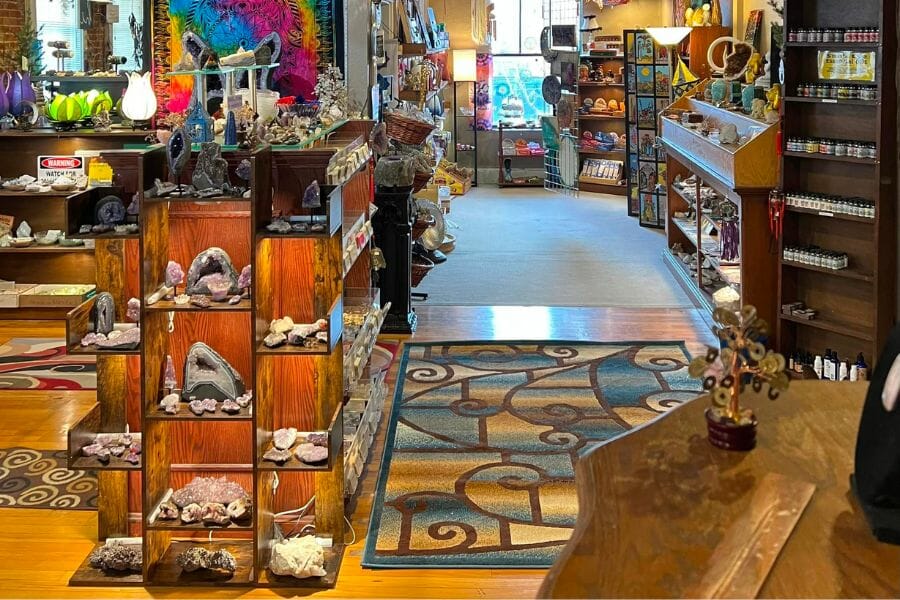
In many cases, finding crystals is no easy feat— it requires tons patience and hard work. If you’re somebody who prefers to go the easy, but surefire way to take home Missouri crystals, your best bet is by visiting the local crystal shops here. Check these out!
- Prospectors Crystals, Rocks & Gift Shop – 1640 Gravois Rd, High Ridge, MO 63049
- STL Rocks – 2003 Cherokee St, St. Louis, MO 63118
- Fall Creek Rock Shop – 11010 Dillon Outer Rd, Rolla, MO 65401
- Ashley Fay Crystals – 7574 MO-266, Springfield, MO 65802
- Blue Lavender Sky – 1462 N Grant Ave, Springfield, MO 65802
- Pathways – 11419 Concord Village Ave, St. Louis, MO 63123
- White Light Crystal Shoppe – 115 E Gregory Blvd, Kansas City, MO 64114
- Enchanted Attic – 304 S Main St, St Charles, MO 63301
- One Of A Kind – 1819 W 76 Country Blvd Suite E, Branson, MO 65616
- Spectrum A New Age Shop – 7827 N Oak Trafficway, Kansas City, MO 64118
Additional places to find crystals in nearby states
If you’ve already tried all of our recommendations above or are planning a trip out of the state, you should check out our guides for neighboring states:
- Crystals in Iowa
- Crystals in Illinois
- Crystals in Kentucky
- Crystals in Tennessee
- Crystals in Arkansas
- Crystals in Oklahoma
- Crystals in Kansas
- Crystals in Nebraska
If you have any recommendations we haven’t covered, please leave them in the comments below!
33 Excellent Spots To Find and Dig For Crystals In Arizona In 2024
Our 29 Favorite Locations To Find and Dig For Crystals In Maryland In 2024
About Dr. Keith Jackson - Geology PhD
Keith Jackson is an avid rockhound who is constantly exploring new sites to expand his collection. He has worked as a professional Geologist for over 20 years and holds a PhD in Geology from the University of Nebraska-Lincoln, a Masters Degree in Geology from the University of Nebraska-Lincoln, and a Bachelors Degree in Geology from the University of Connecticut.
Leave a Comment Cancel reply
Reach out to us with your questions.
We always love to hear new suggestions and answer any questions you might have!
© 2024 Rockchasing.com
5540 N Lamar Blvd Suite 1 Austin, TX 78756
Your cart is empty
Have an account?
Log in to check out faster.
Estimated total
Each time you leave a review, share and tag us on socials @consciouscrystals.co.nz you'll receive 500 loyalty points to go towards a discount on your next order!
FREE CRYSTAL CONFETTI FOR ORDERS OVER $60
Can you go Crystal Hunting in New Zealand?
I have written on this subject before, but of course I accidentally deleted it! So I've re-written it for all my crazy New Zealand crystal lovers! I hope you find this helpful.
As we know, Gemstones can be found all over the world. We are incredibly lucky to be able to experience such powerful crystals and energy through what the earth provides for us.
Crystals can even be found here in little New Zealand! We don’t have any extremely precious minerals like diamonds or emeralds, but we do have some gorgeous stones that are sacred to us and our communities.
Now, before I tell you about them, we need to talk. If you go out hunting for gemstones, it can be offensive to the land and our native cultures to remove the gemstones from their place. Without proper ceremony or giving back to the earth for what you take, it would be better to leave the gemstones where you found them. I do not know that ins and outs of what is culturally sensitive, but it would be safer to be respectful.
A quick side note, if you want to take a piece of nature home with you, spiritually it is good to ‘pay’ or give back for that. For example, when I go to the beach, I love collecting shells. However, I will not take them home from the beach without giving something in return. I often pick up litter, or meditate to say thank you to the earth, often both. Spirituality is about appreciating the human experience and the earth that we live on whilst maintaining upmost respect for it.
Also please remember that the ownership of Pounamu belongs to Ngāi Tahu, so it is illegal to collect any more Jade than you can carry by hand south of Nelson. Dan Hikuroa, earth system scientist and senior lecturer in Māori studies at the University of Auckland, pounamu is the fragments of Waitaiki, wife of the chieftain Tamaahua, who was kidnapped by the taniwha Poutini and metamorphosed into stone before her husband could rescue her. Pounamu can be found at the sites Poutini visited as he fled Tamaahua down the west coast of the South Island. (3).
What Crystals can be found in New Zealand?
Back on topic, these are some of the main crystals that can be found here in New Zealand.
- Quartz family; Amethysts and Agates.
- Jasper family.
- Peridotite.
- Garnets; Pink, Red or Yellow.
- Pounamu; also known as Greenstone, New Zealand Jade or Nephrite Jade. Serpentine.
- Goodletite.
How do you find Crystals?
Obviously this is not an easy feat. Crystals are rare enough as it is, but they have to go through a long process before they even end up in places where people can find them.
Most of our Crystals in New Zealand come from our greywackle mountain ranges. They break off of boulders and wash into rivers and streams that carry them to sea. The ocean breaks them up into smaller pieces, tumbling them into smooth stones which eventually get washed up on beaches.

What particular locations can you find Crystals in NZ?
- Granity, West Coast South Island.
- Birdlings Flat, Christchurch.
- Coromandel Peninsula.
Number 4 on our reference sheet has a very detailed account of locations within New Zealand and what you can find there. Make sure you visit that site and have a read.
This is also another incredibly useful resource, NZ Gemstones by Jocelyn Thornton. It is downloadable through this link.
References:
- https://teara.govt.nz/en/map/5113/rock-collecting-sites-in-new-zealand
- https://teara.govt.nz/en/gemstones
- https://www.nzgeo.com/stories/rock-hounds/
- https://www.reddit.com/r/newzealand/comments/7gzbvi/grow_your_rock_collection_summer_rock_hunting/ this is a great resource for more specific rock hunting locations within New Zealand.
Leave a comment
Please note, comments need to be approved before they are published.
- Choosing a selection results in a full page refresh.
- Opens in a new window.
Let customers speak for us
Beautiful ring! Love it. Arrived very quickly and was also gifted a lovely bracelet which looks like tiger's eye. Thanks so much, highly recommend both the product and the company.
Very pretty!
Love my Chakra Crystals - the perfect size. The parcel arrived at the perfect time - wisdom came right when I needed it. Surrender - leave the rest to the universe! Thankyou
Super efficient service. Ordered on a Sunday and products arrived on Tuesday. Very happy customer, thank you 🙏

IMAGES
COMMENTS
201 W Broadway St, Philipsburg, MT 59858, USA. Phone +1 406-859-4367. Web Visit website. Gem Mountain is located in Philipsburg, Montana, a remote area in western Montana. The time it takes to get there is worth the fun you'll have digging for sapphires. Everything you need to get started will be provided with admission.
As a gem hunter's paradise, our state is rich in different places for this activity. Aside from our favorite areas, we also made a list of the other great locations that adults will have a blast exploring. Cave Creek - Agate, Jasper, Magnetite, Quartz. Ajo - Agate, Chalcedony, Jasper.
Golden Gate Canyon State Park. 92 Crawford Gulch Rd, Golden, CO 80403, United States. Golden Gate Canyon State Park is a state park located in Gilpin County near the town of Golden and is easily one of the most beautiful places to dige for gems in Colorado. The park is 12,000 acres of scenic beauty in the foothills of the Rocky Mountains.
The Quartz Mines of Arkansas, USA. The Quartz Mines of Arkansas, USA, stands as a shimmering beacon in the world of crystal hunting, attracting enthusiasts from all corners of the globe. Located in the scenic state of Arkansas, this destination has earned a reputation for its abundance of quartz crystals. Arkansas is called the "Quartz ...
For families who are wanting to expose and introduce their children to gem mining, here are some of the best family-friendly places to successfully do so. Rock Creek Wildlife Area - NF-1701, Goose Prairie, WA 98937. Shi Shi Beach - Shi Shi Beach Rd, Clallam Bay, WA 98326.
The Emerald Hollow Mine is home to the only emerald mine in the United States open for public treasure hunting. You can check out findings from the mine at sluiceways or do your own prospecting, digging, and hunting for a small fee. Gem sluice, Hiddenite, NC. Photo by Robert Nunnally. Licensed under CC By 2.0.
Other Great Crystal Hunting Sites in the US. Salt Plains National Wildlife Refuge, Oklahoma: A 32,197-acre refuge in north-central Oklahoma, where you can dig for selenite crystals. The crystal digging season is from April 1 to October 15, and admission is free. You can keep up to 10 pounds of crystals per day.
Today, it's privately owned and is a popular site to hunt for amazonite, a greenish gem named after the Amazon River, and 80 other gems and minerals. Located 300 feet under ground and stretching ...
$50,000 Crystal Treasure Hunt. AmericanGemTracker - Brian Busse & Jeremy Fuller (Searle Canyon Red Beryl Mine, Topaz & Bixbyite. ... My son and I met up with Jeremy and John to experience the Guided tour of the Red Beryl Mine, as well as the Solar Wind Mine.I cannot recommend the guided tours enough. Aside of knowing exactly where to did, John ...
The area's legacy, however, lies in the more than 300 mineral species that have been uncovered in the search for silver. Azurite, malachite and turquoise are among the most well-known. An 18.97 ct polished freeform Chrysocolla gem with areas of drusy quartz and a 33.30 ct. Chrysocolla oval cabochon. Both are from Arizona.
Guided Arizona Gem Hunting Tours. Arizona was made famous during the mineral rushes of the Wild West for its many riches. Boomtowns were formed, including some of the most wild and famous towns of the Old West; Tombstone, Bisbee, and Jerome, which are still bustling towns today. The precious ore industry is still strong here, with copper being ...
Below, find 6 places you can indulge your crystal addiction, feel like an old-school explorer, and, maybe, make bank. Photo: Stocksy/Chelsea Victoria. 1. Emerald Hollow Mine, North Carolina ...
1. Crystal Vista. If you're a rockhound who lives in or near Arkansas, and you're always on the lookout for places to go to dig crystals, then chances are you've heard of the Crystal Vista crystal dig site. There's plenty of quartz crystals to be found here and it's completely free. You just have to be willing to make the 20 minute ...
82 Wegner Crystal Ranch Rd, Mt Ida, AR 71957, United States. Wegner Quartz Crystal Mines is a quartz crystal mining operation located in the small town of Mt. Ida. Wegner has been mining quartz crystals since 1995. The mine is open to the public and offers a variety of guided tours and educational programs for gem hunters.
Here are the top 9 places to dig for crystals in the United States: Crater of Diamonds State Park, Arkansas. Emerald Hollow Mine, North Carolina. Jade Cove, California. Cherokee Ruby and Sapphire Mine, North Carolina. Herkimer Diamond Mines, New York. Rainbow Ridge Opal Mine, Nevada.
Some visitors have come across Chalcedony (Desert) Roses as well as Druse Crystal Clusters. You're able to trod along the claims for 30 dollars a day and salvage whatever you discover on the land. Rockhounding Arizona Location: 9049 Oatman Rd (Old Route 66), Golden Valley, AZ 86413.
A visit to the Oceanview Mine allows you a unique view of the only actively working underground mine in the world famous Pala Gem mining district and a chance to find your own gems—tourmalines, kunzites, morganites and more. Screen the dump piles of material we take out of our mine and find the gems we've missed—and we miss a lot!
Getting to the Hansen Creek Trailhead for Crystal Hunting. Trailhead GPS coordinates are: Latitude 47.366° N Longitude121.512° W ( Google Maps Link) The google plus location code is: 9F8Q+95 Bandera, Washington. Get there with Google Maps by using the map below: Crystal Hunting in….
The French crystal hunter uncovers the secrets of his profession without any hesitation: Step 1. Find a crystal oven. "Crystals were once formed about ten kilometers (32,808 feet) beneath the ground. Due to the rise of the Alps, you can now find them on mountain walls in so-called crystal ovens.
Water assisted land-based hunting. Each adult is provided with a hose to assist in washing the fossils out of the matrix material. Our property is located just off US-17 in Bowling Green, Florida, 33834. How to book your Bone Valley Fossil Farm fossil hunting tour: Simply send us a message or email ([email protected]) stating your ...
If you're somebody who prefers to go the easy, but surefire way to take home Missouri crystals, your best bet is by visiting the local crystal shops here. Check these out! Prospectors Crystals, Rocks & Gift Shop - 1640 Gravois Rd, High Ridge, MO 63049. STL Rocks - 2003 Cherokee St, St. Louis, MO 63118.
Join me on an Ontario Crystal Hunting Adventure! In this group I announce my upcoming Rockhounding Tours, I share my Mineral Finds and my Personal Rock Collection, I regularly post Mineral Education...
Add Ons. Each time you leave a review, share and tag us on socials @consciouscrystals.co.nz you'll receive 500 loyalty points to go towards a discount on your next order! I have written on this subject before, but of course I accidentally deleted it! So I've re-written it for all my crazy New Zealand crystal lovers! I hope you find this helpful.